
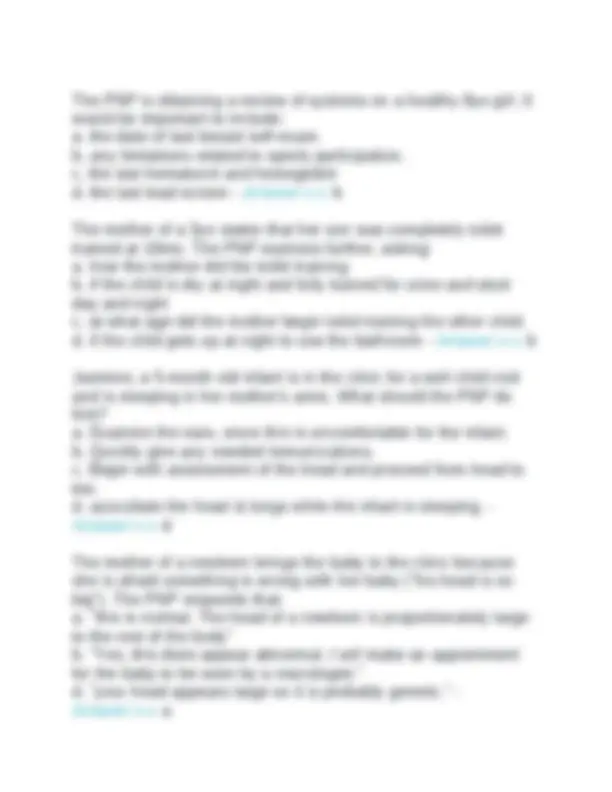
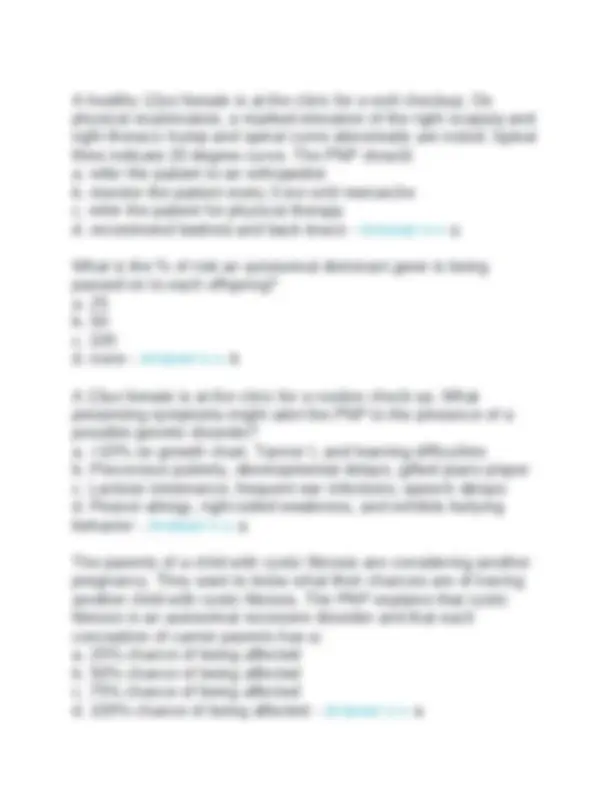
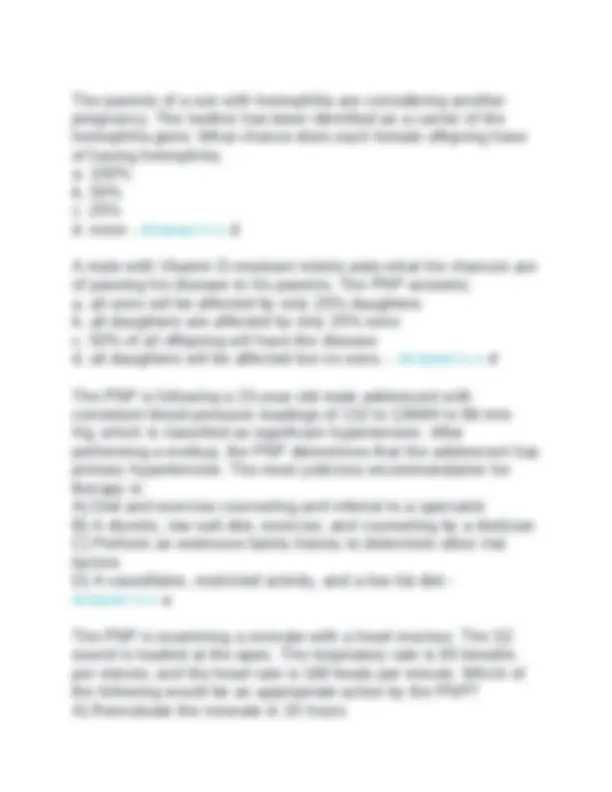
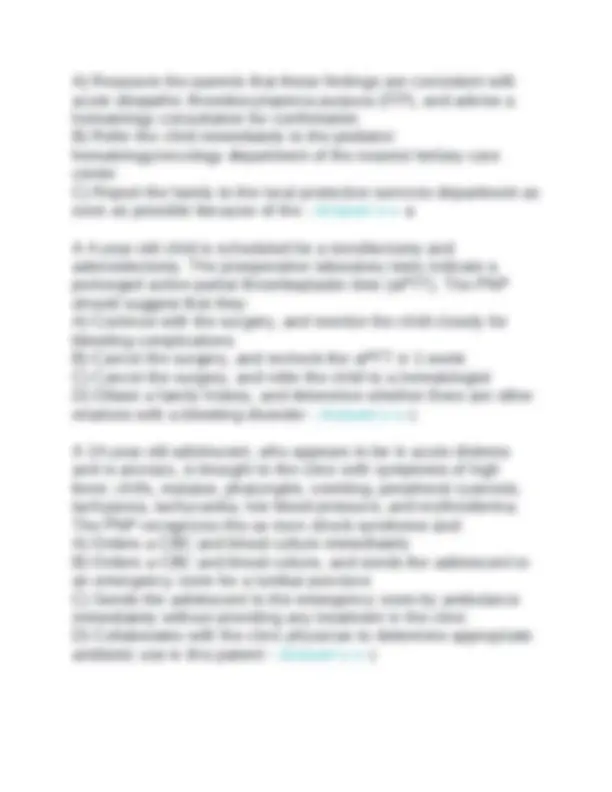
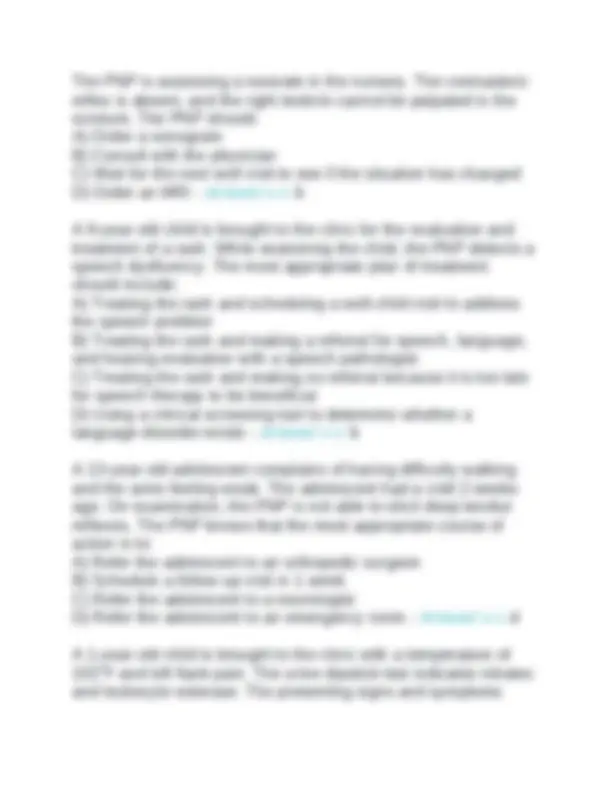
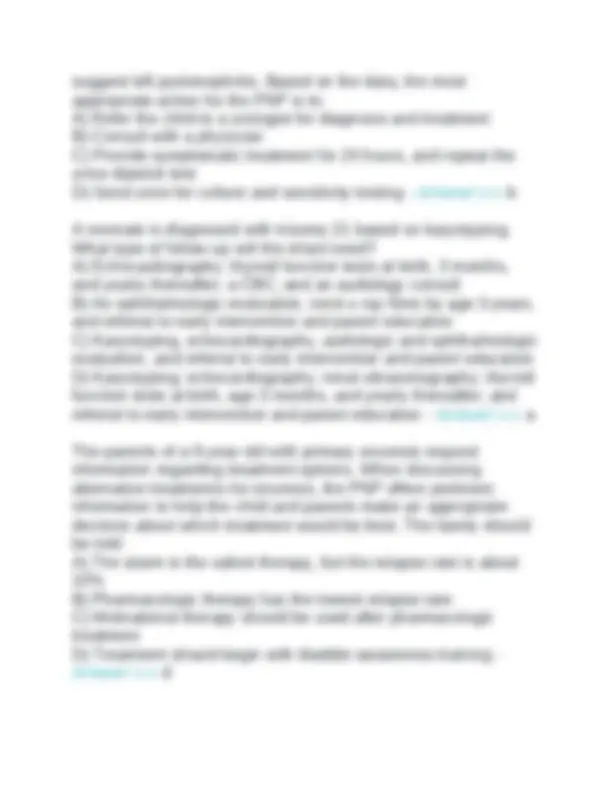
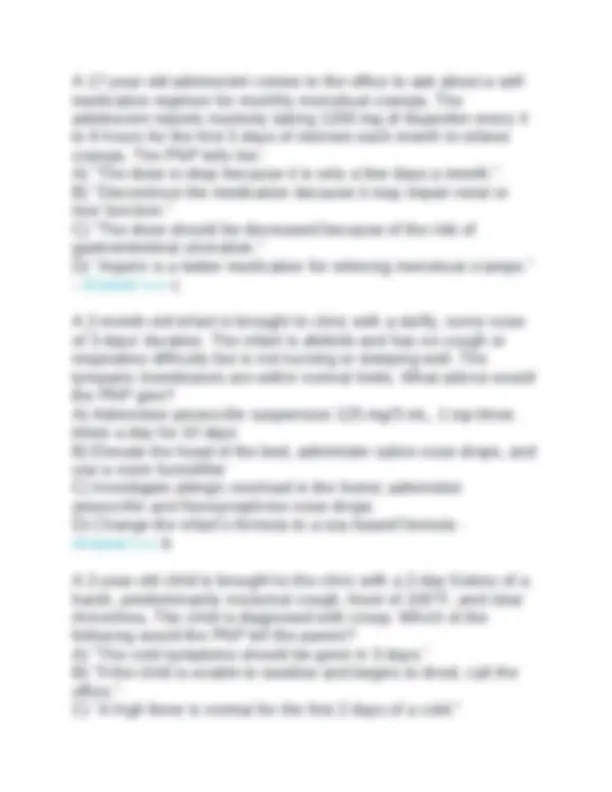
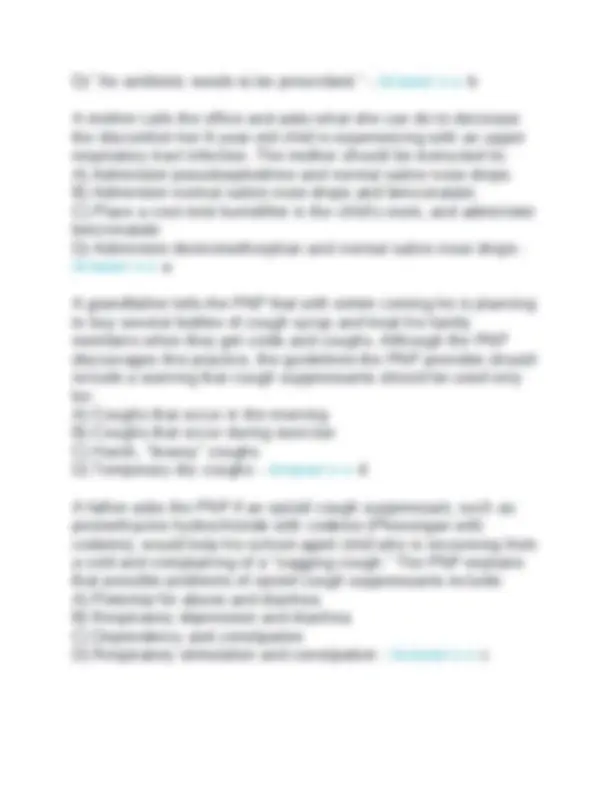
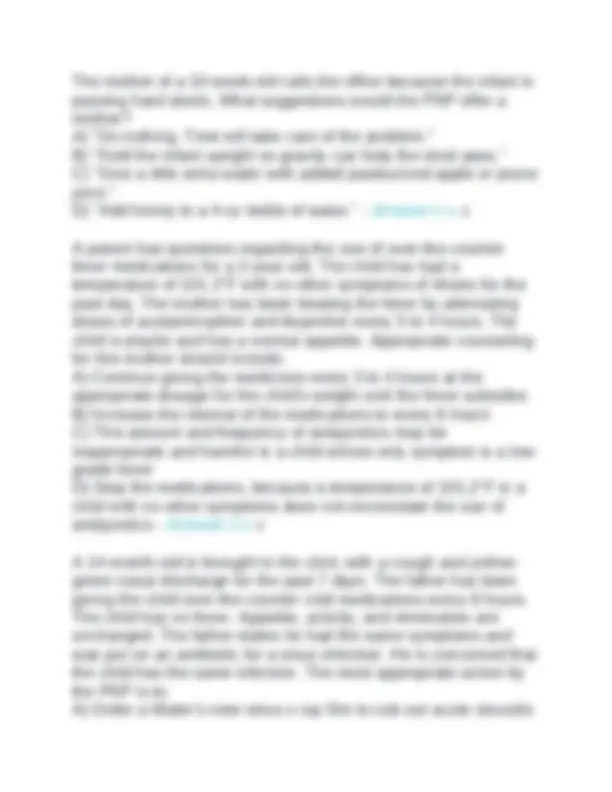
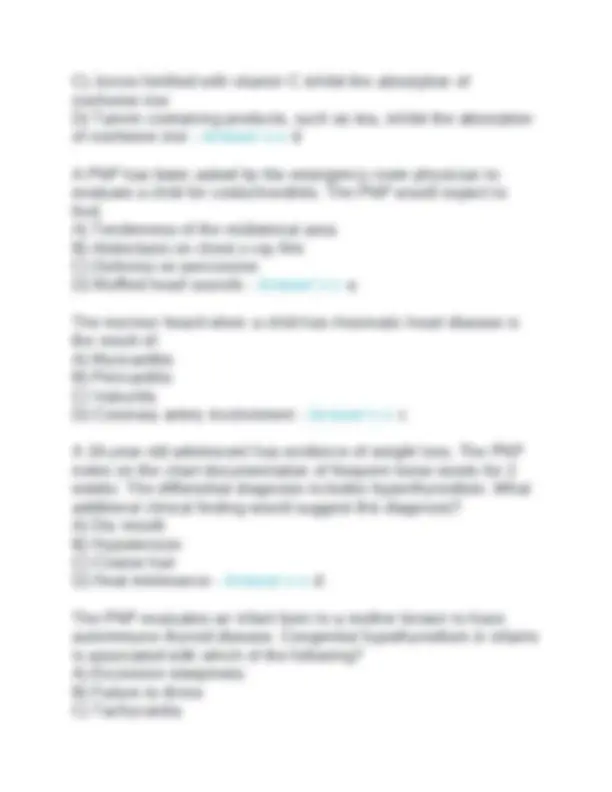
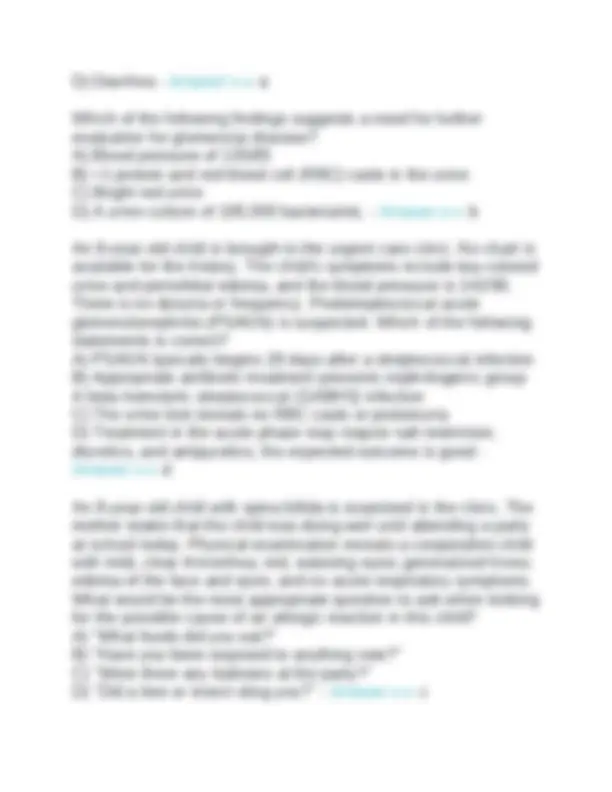
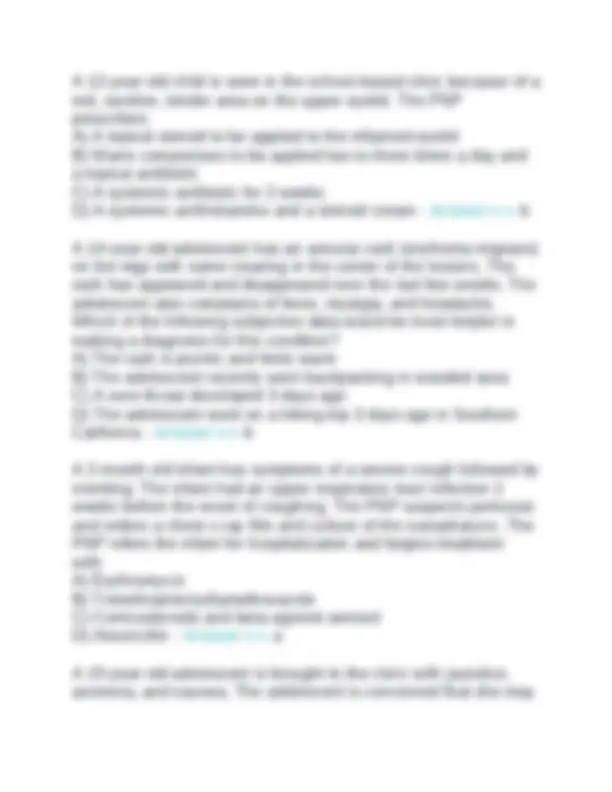
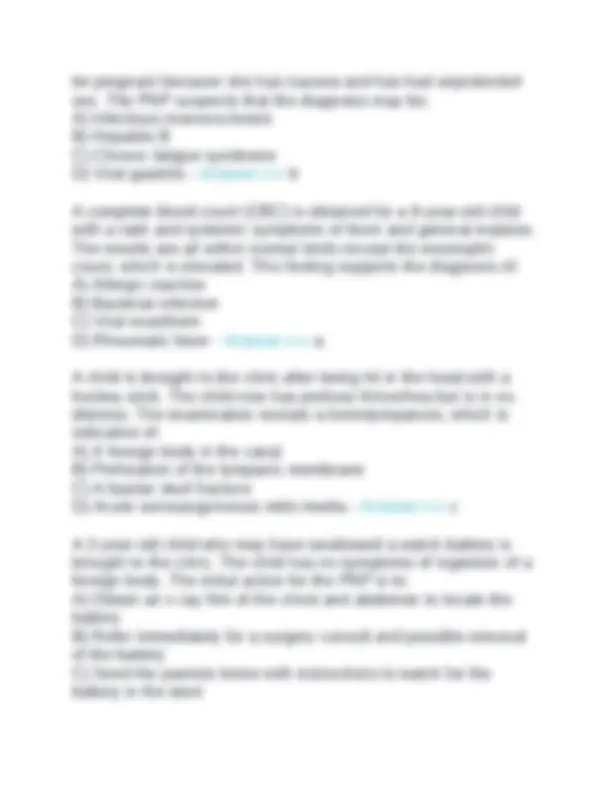
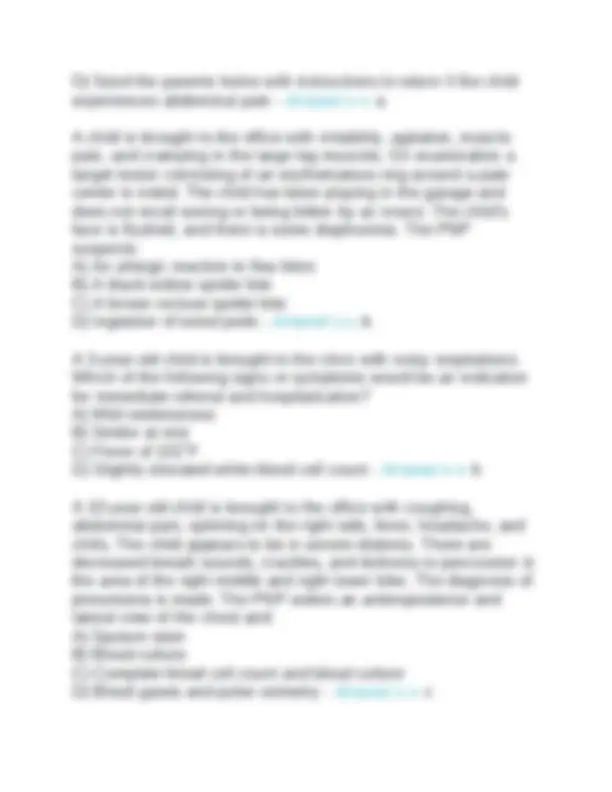
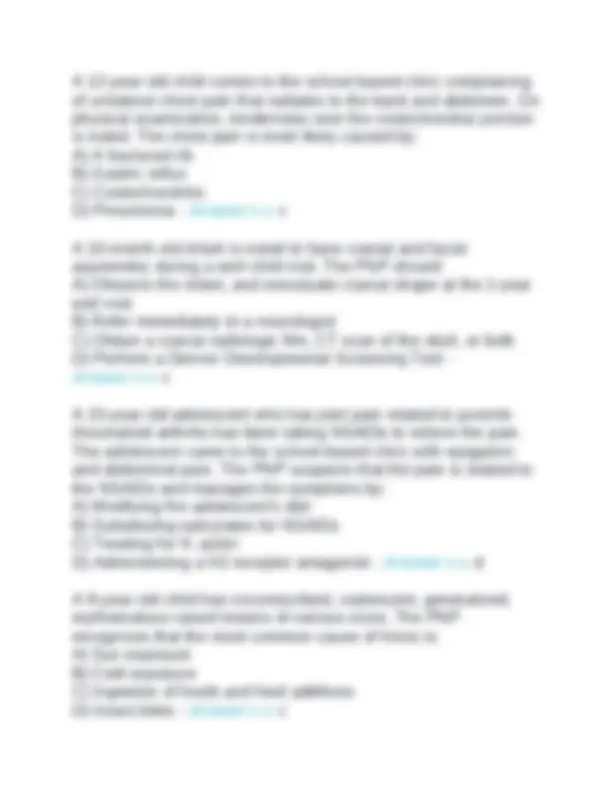
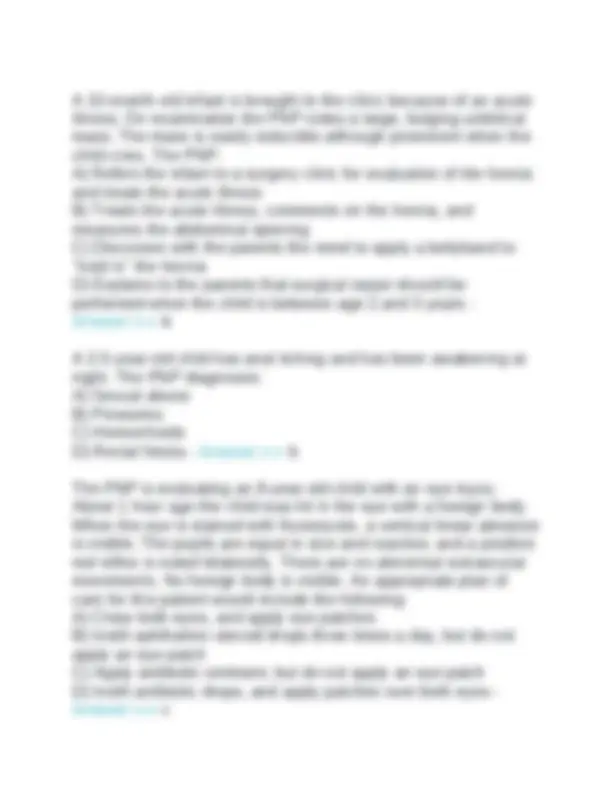
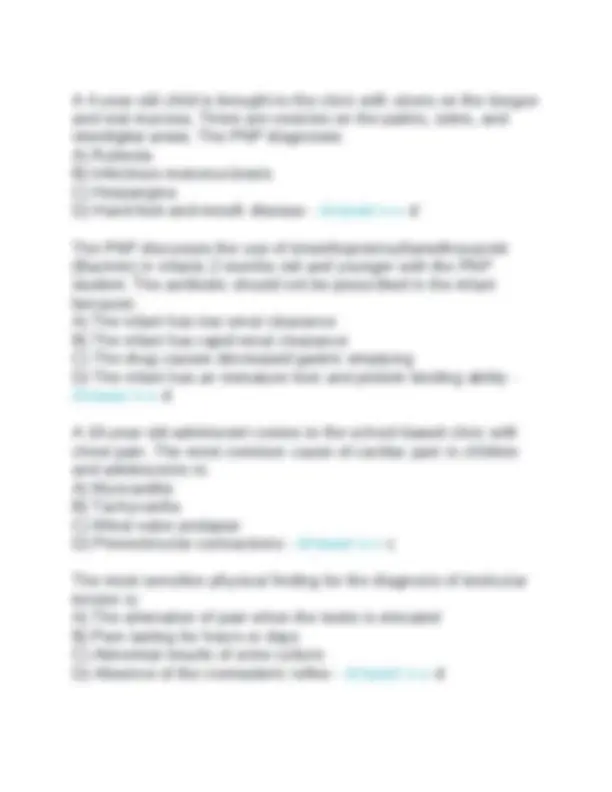
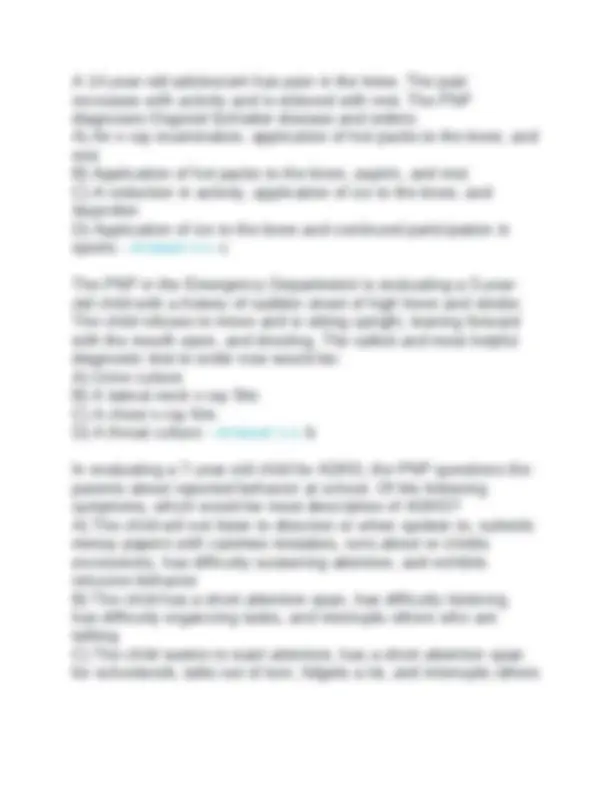
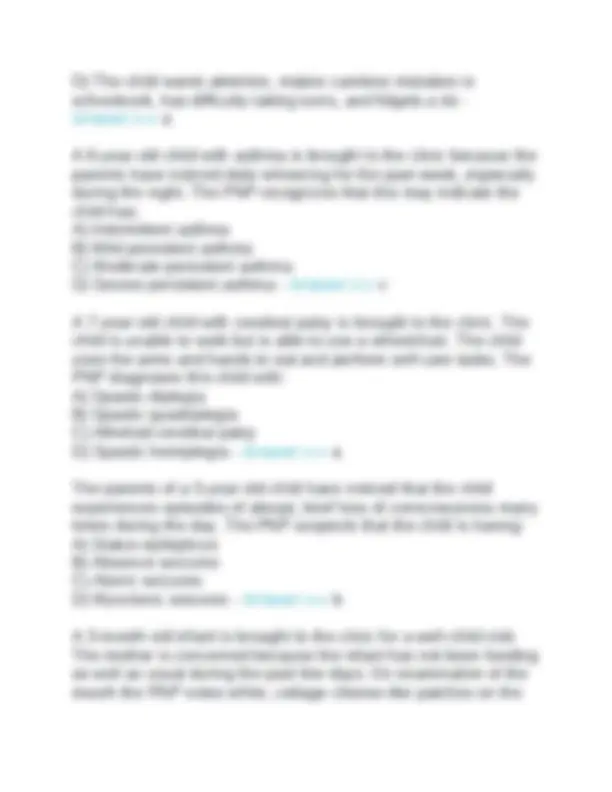
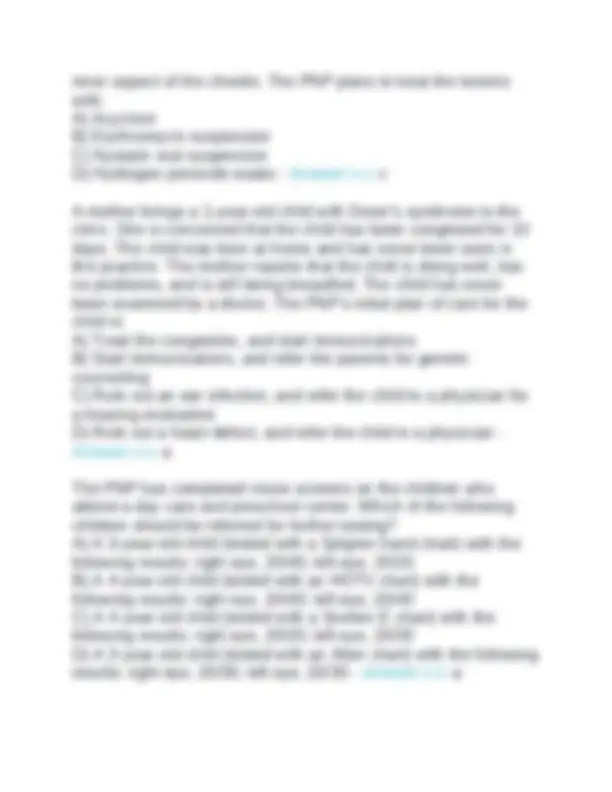
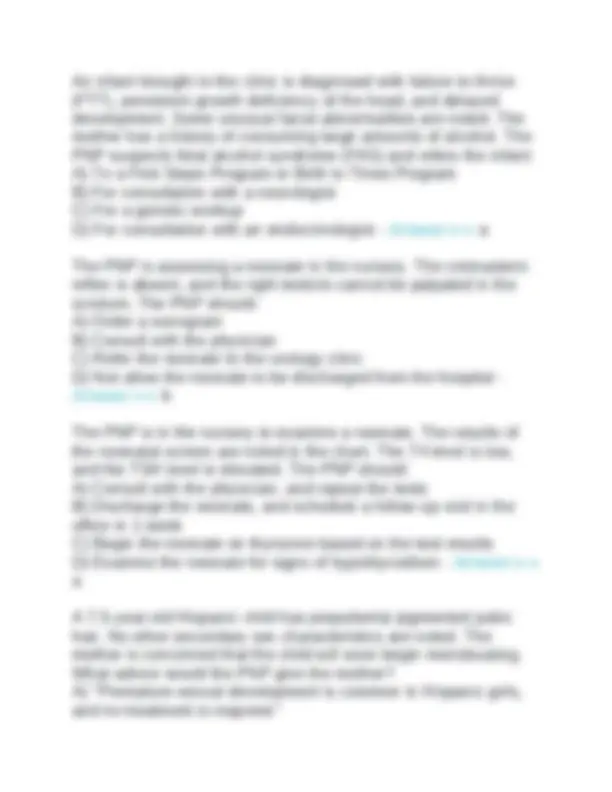
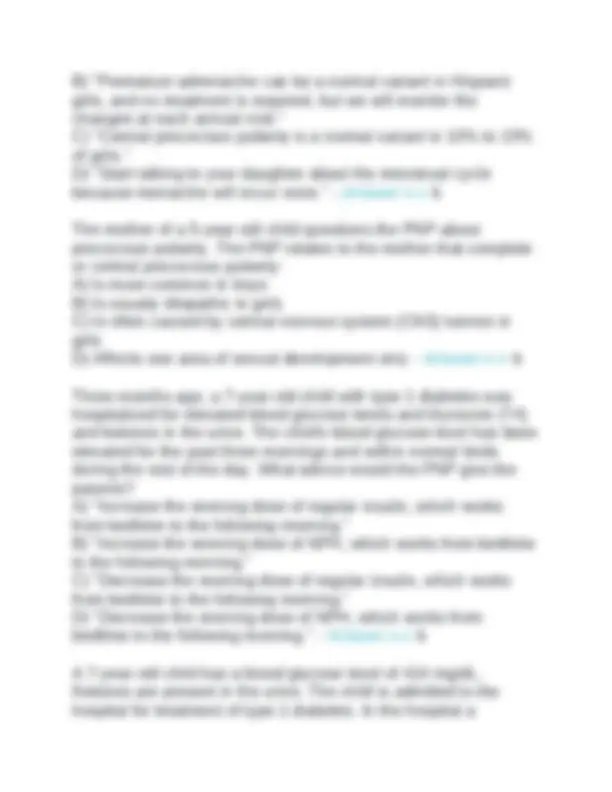
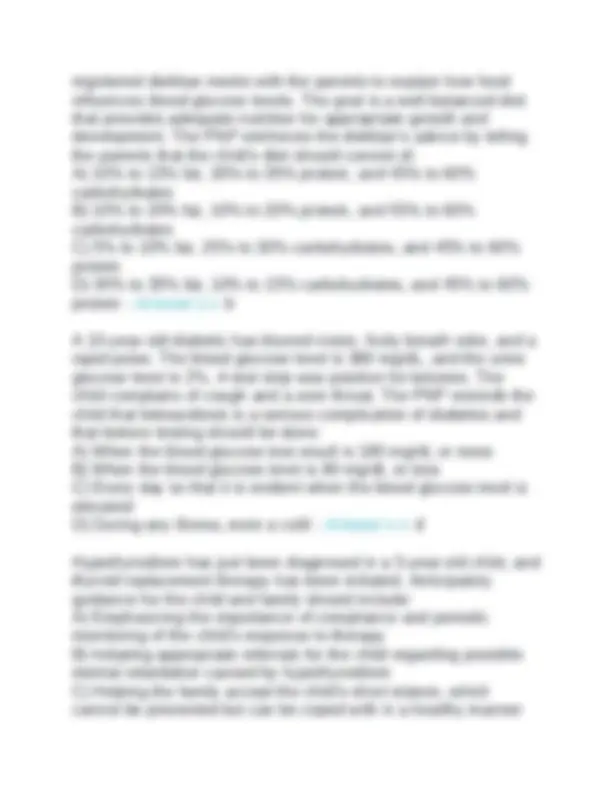
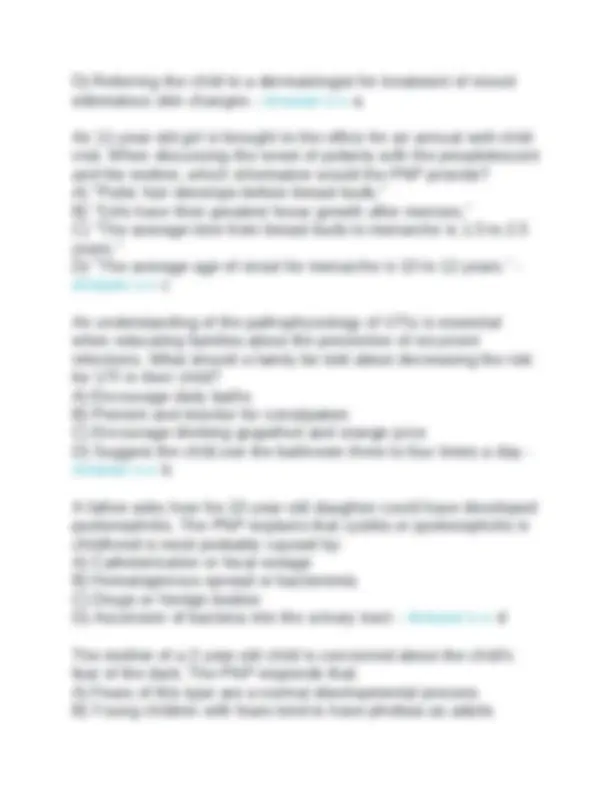
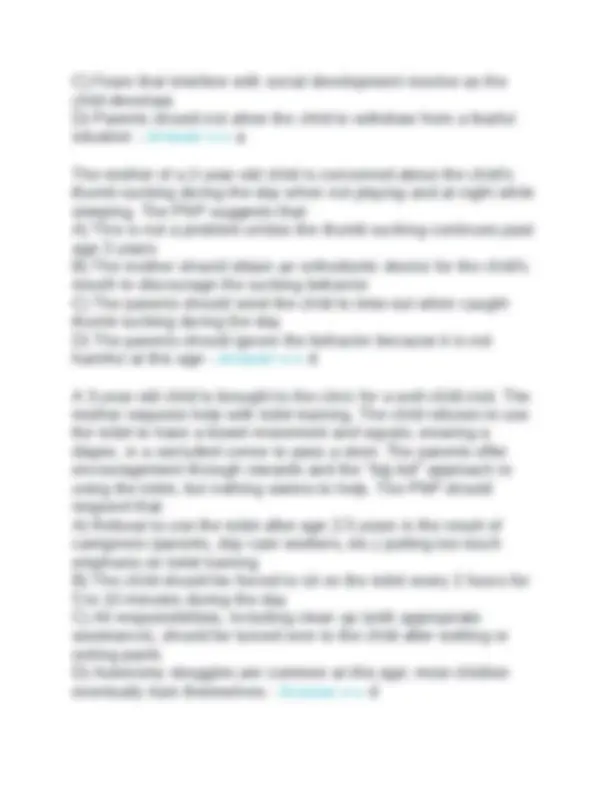
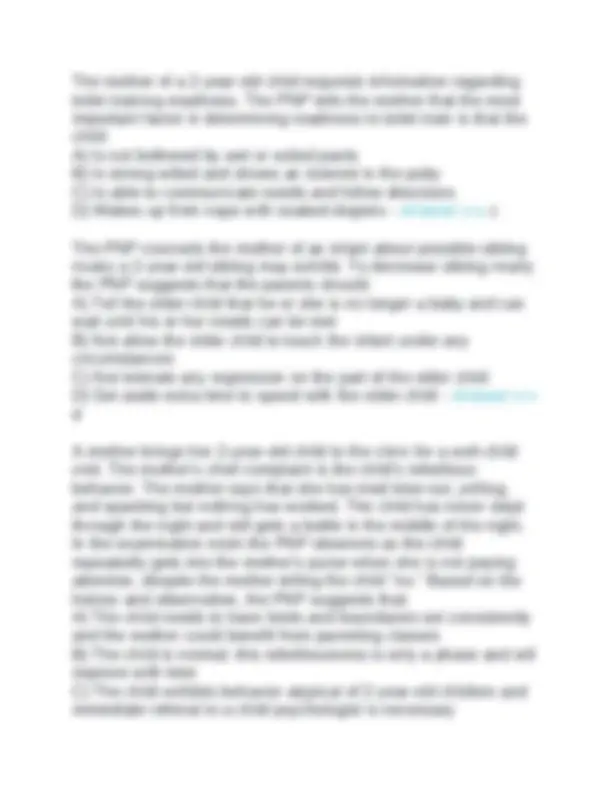
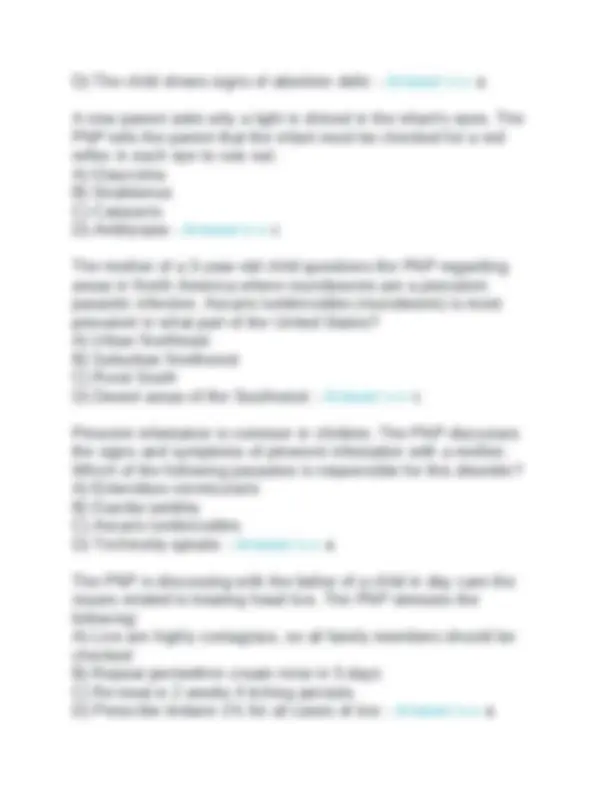
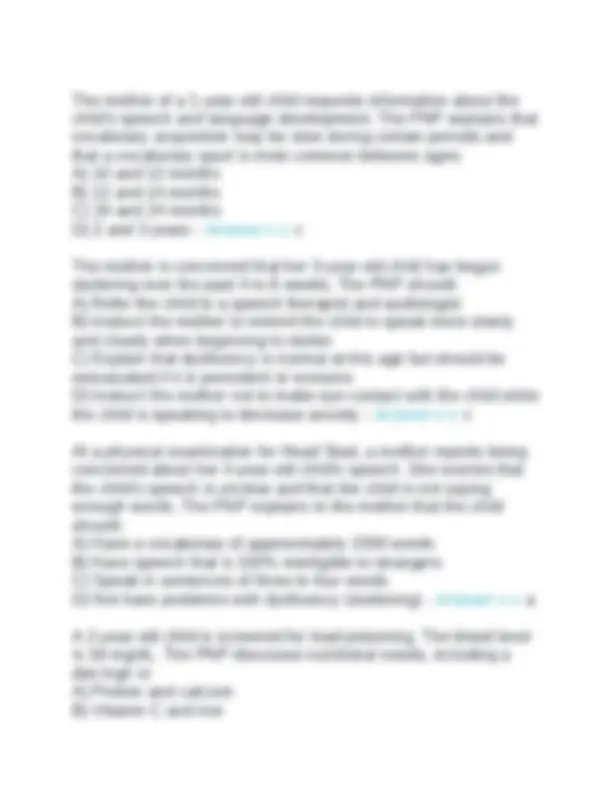
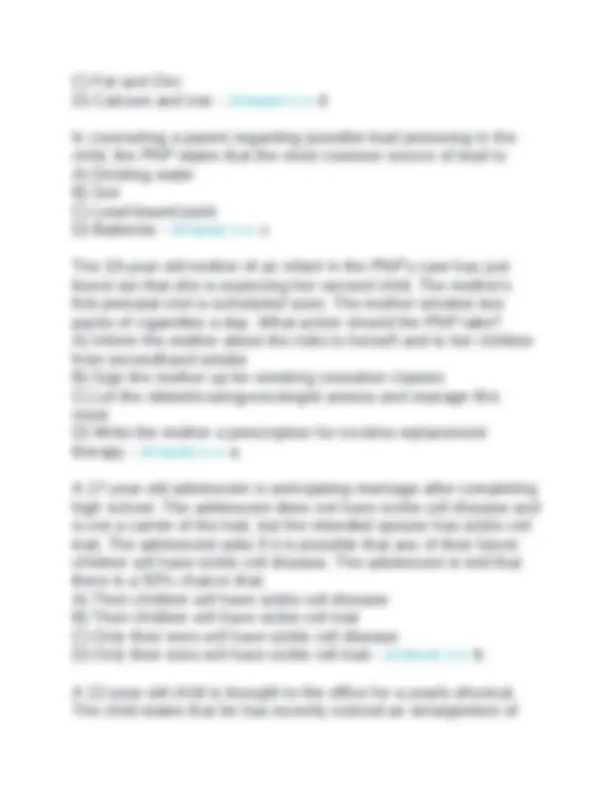
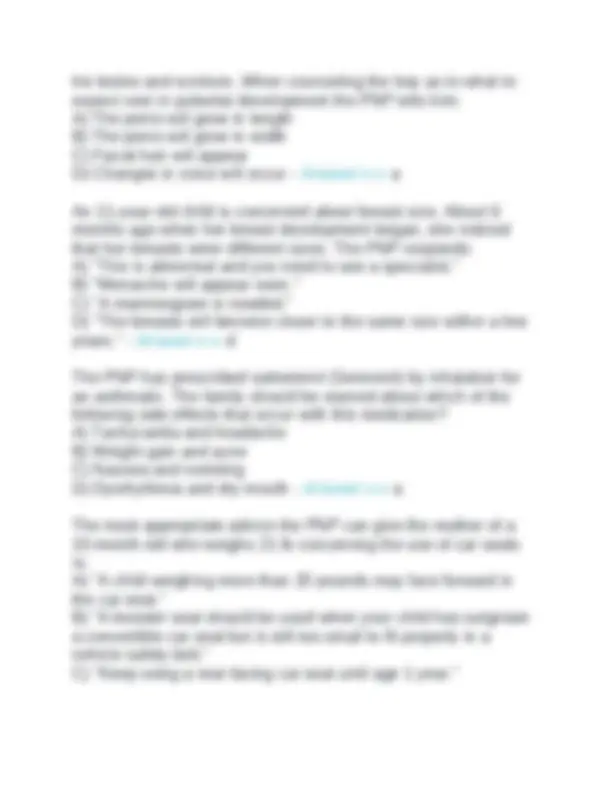
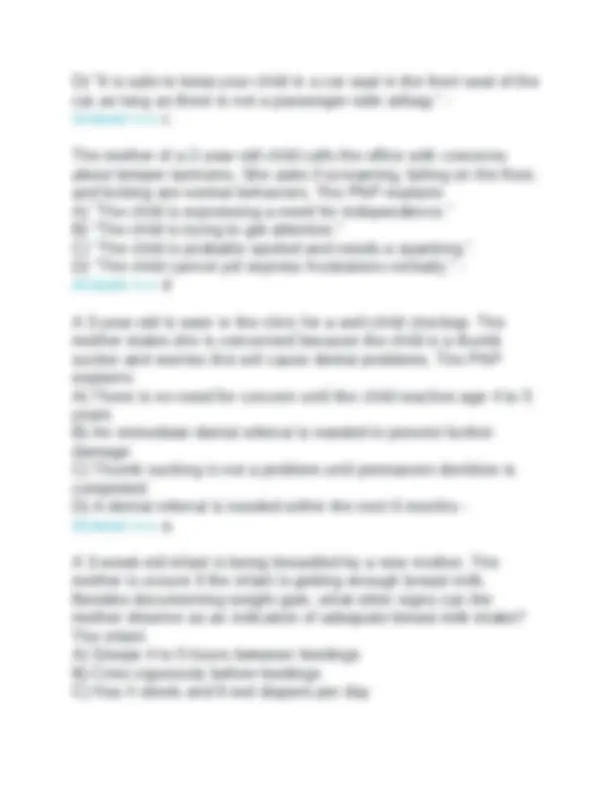
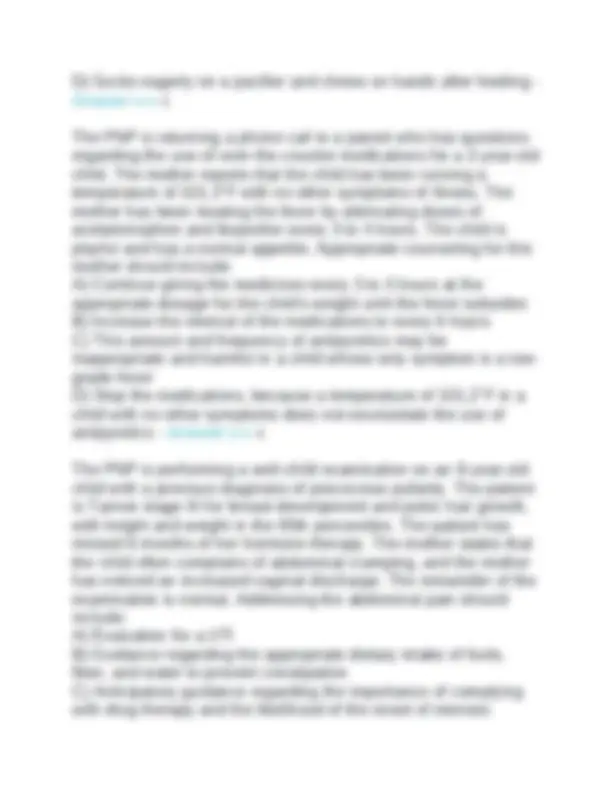
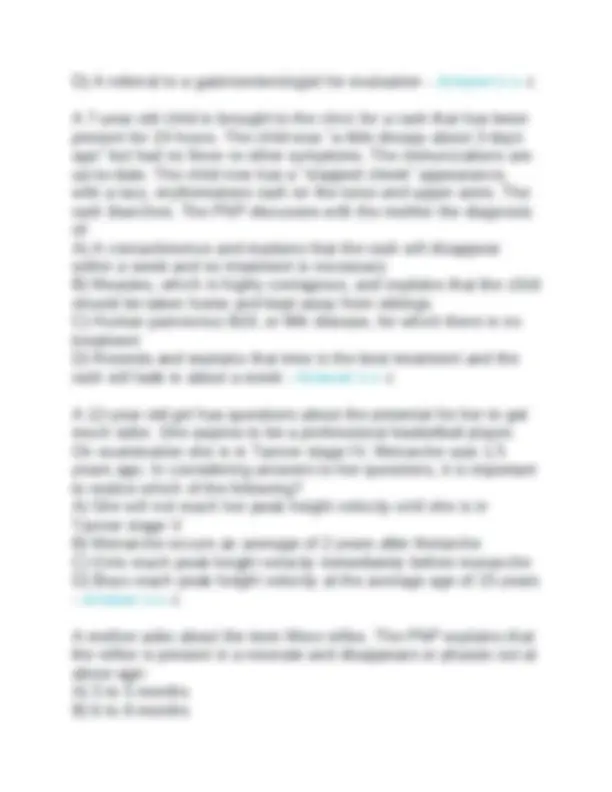
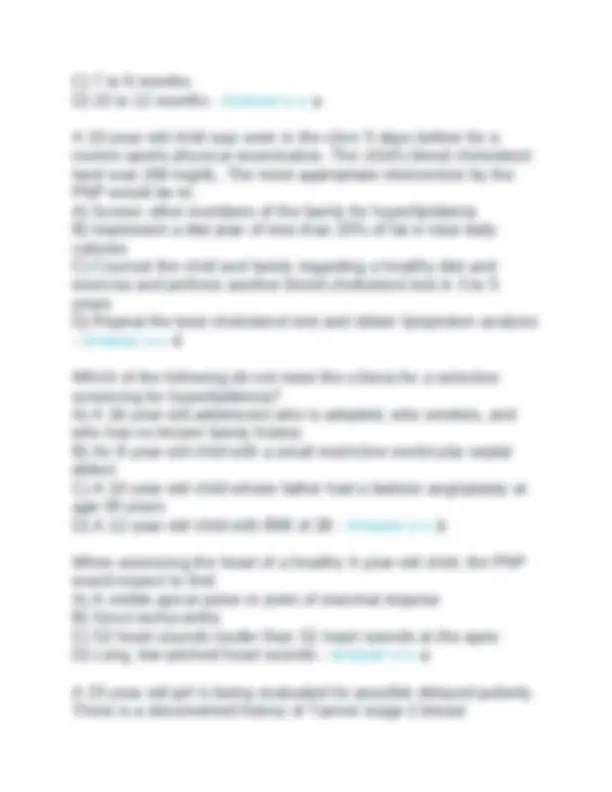
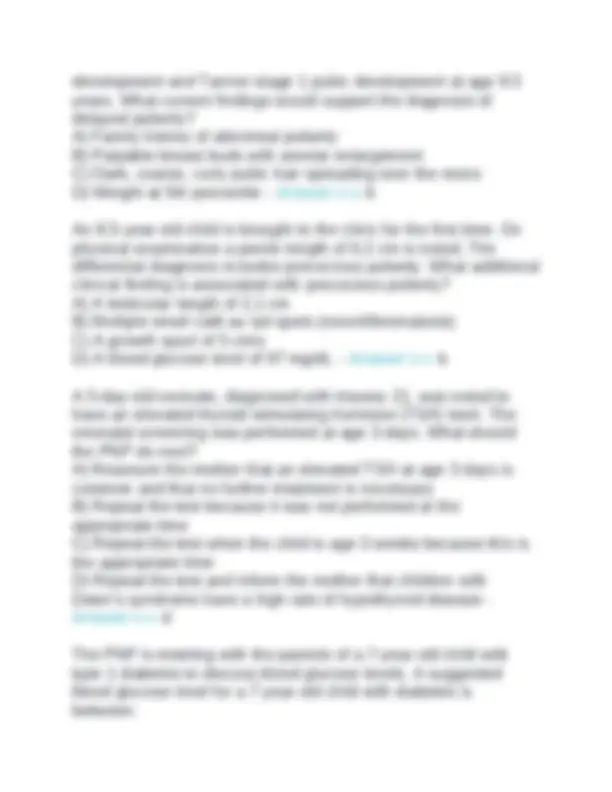
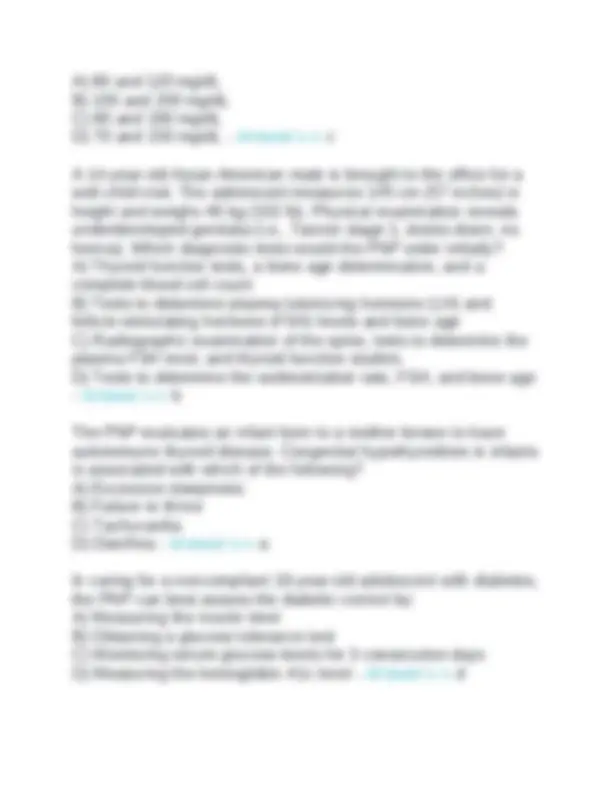

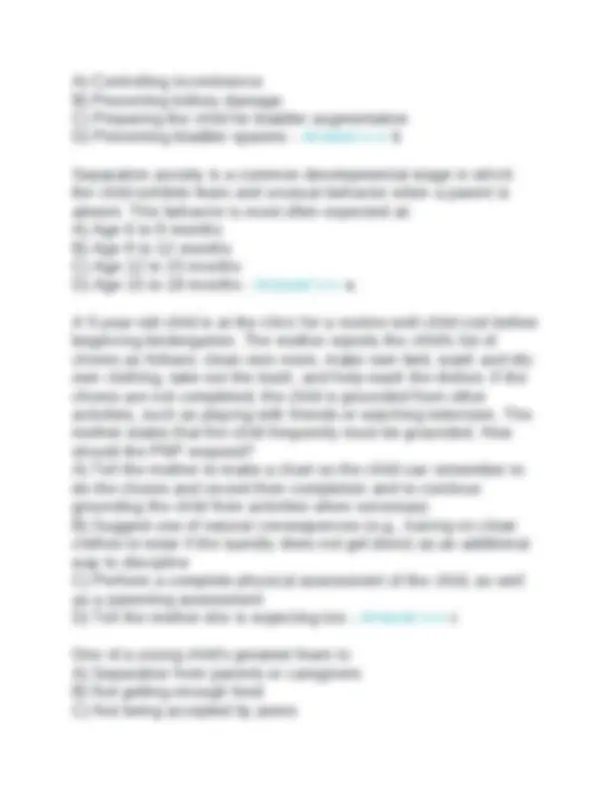
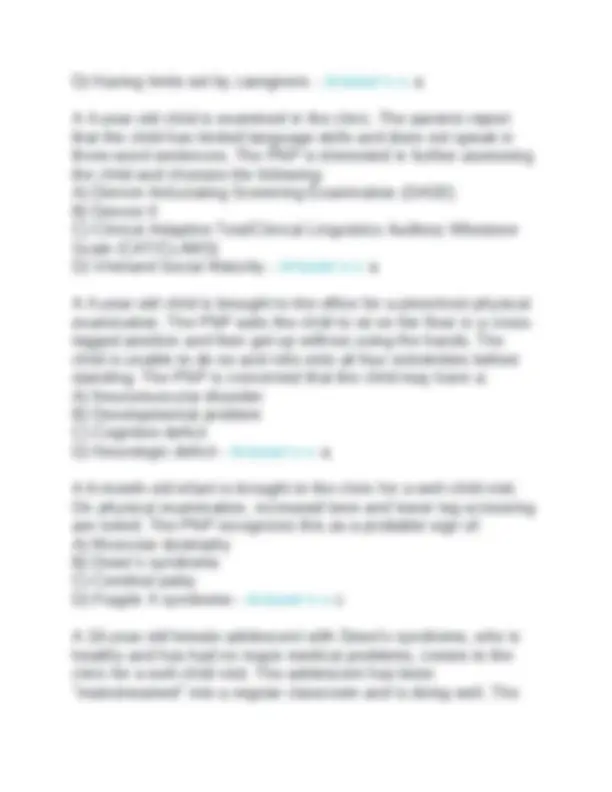
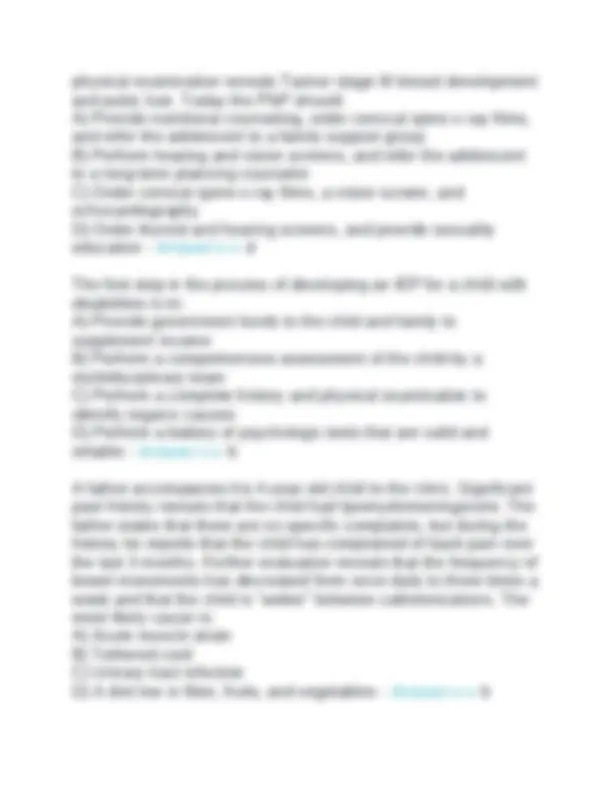
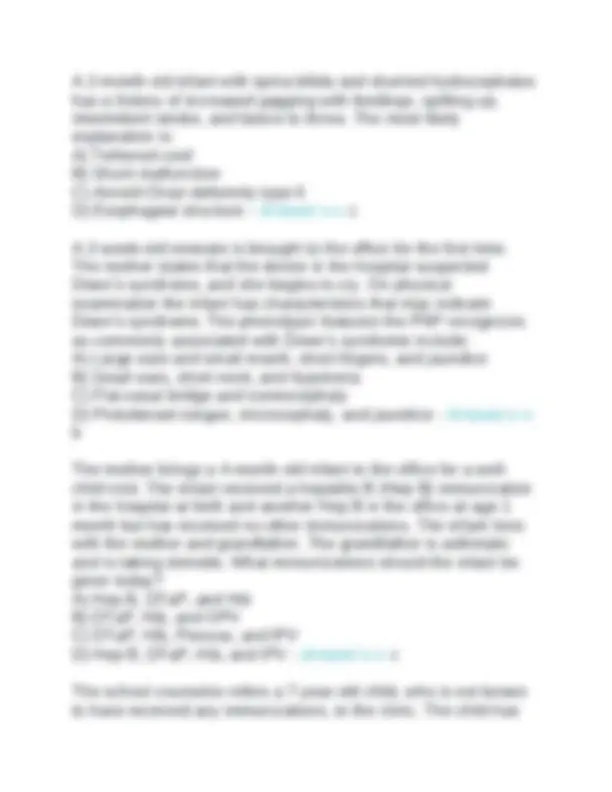
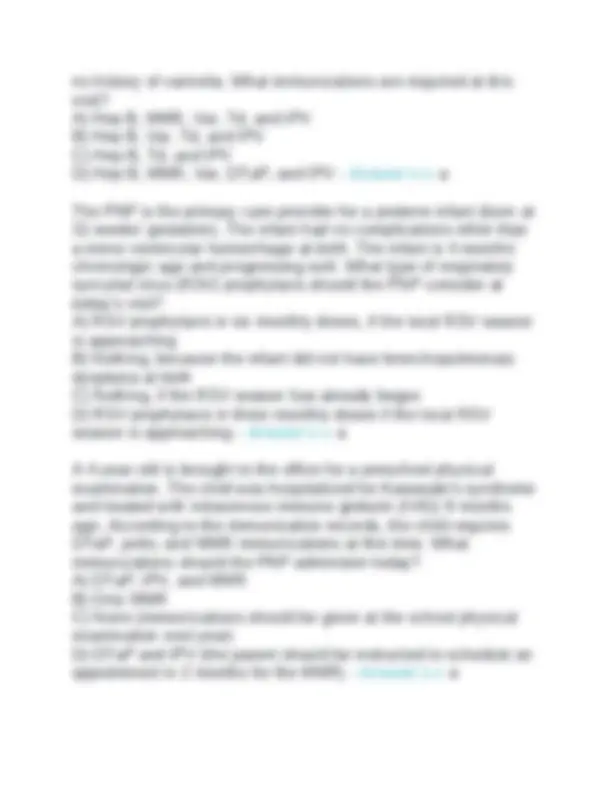
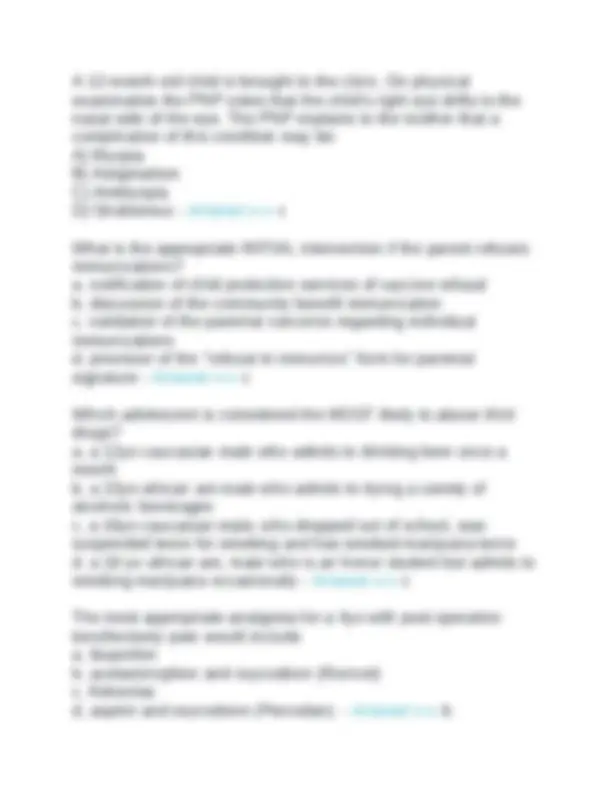
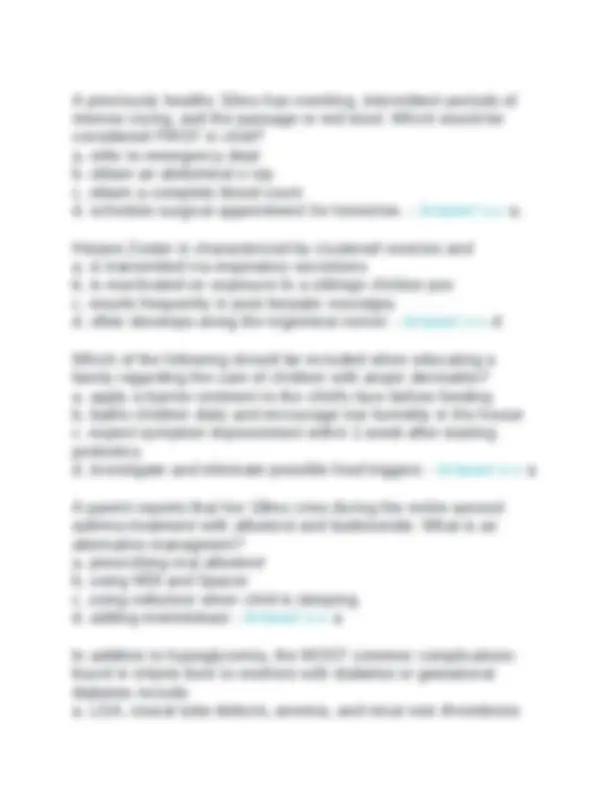
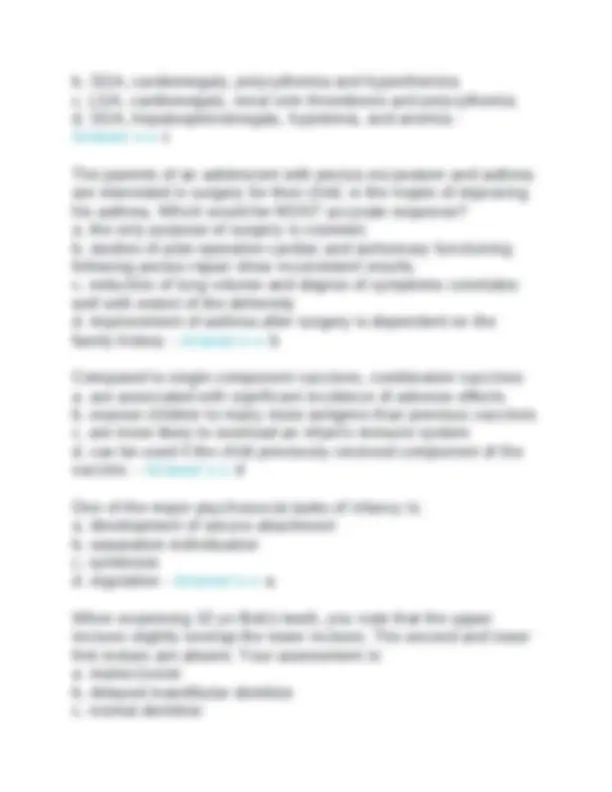
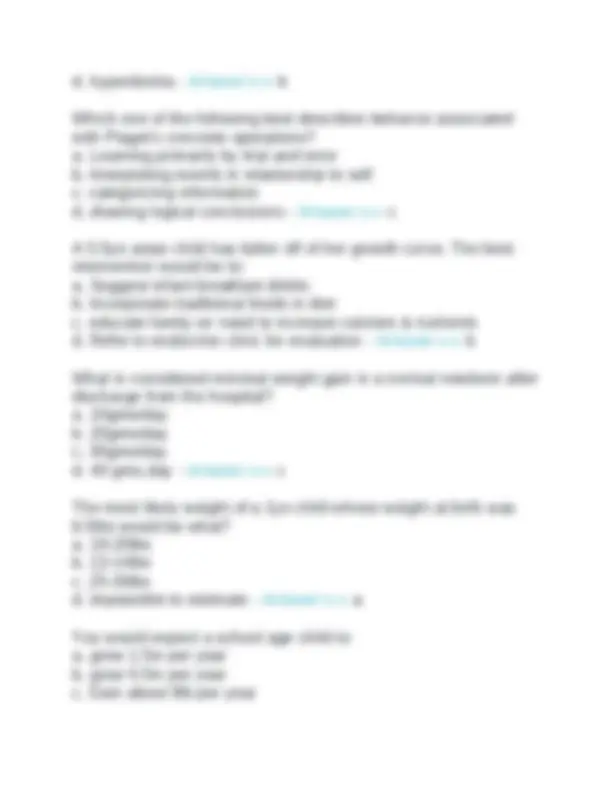
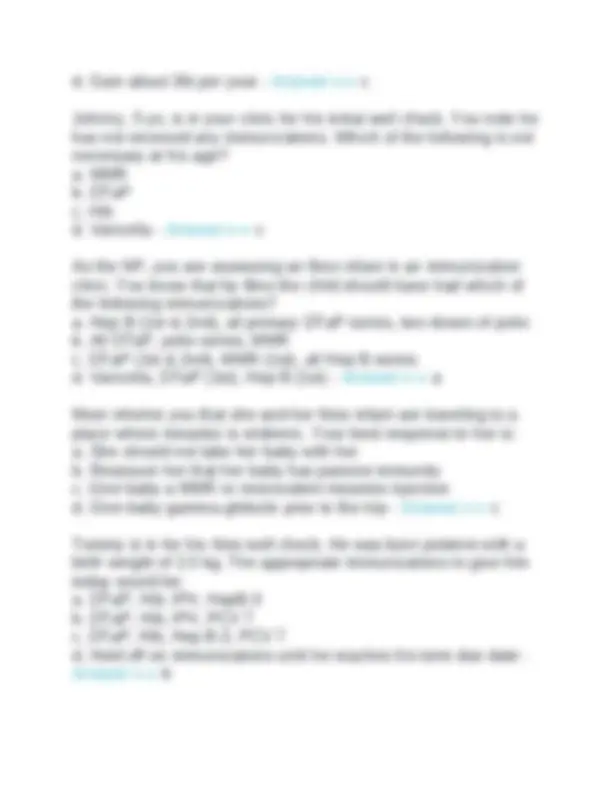
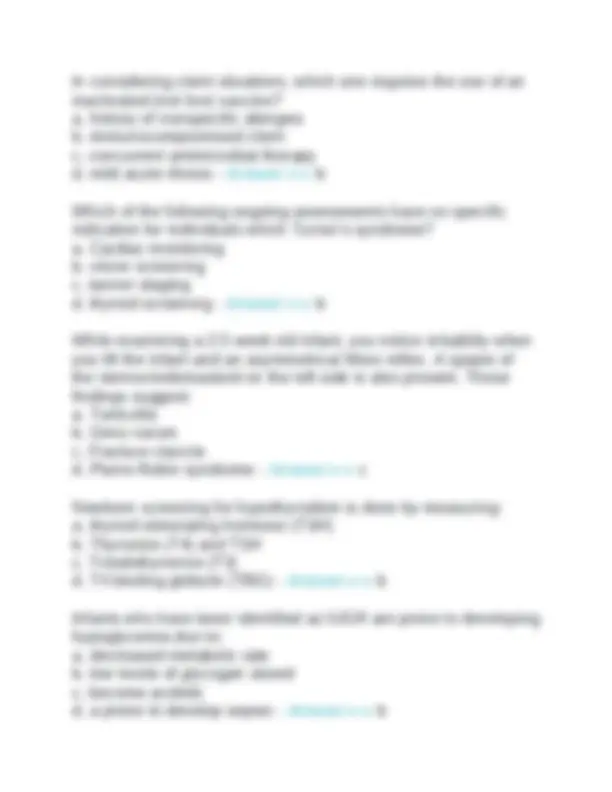
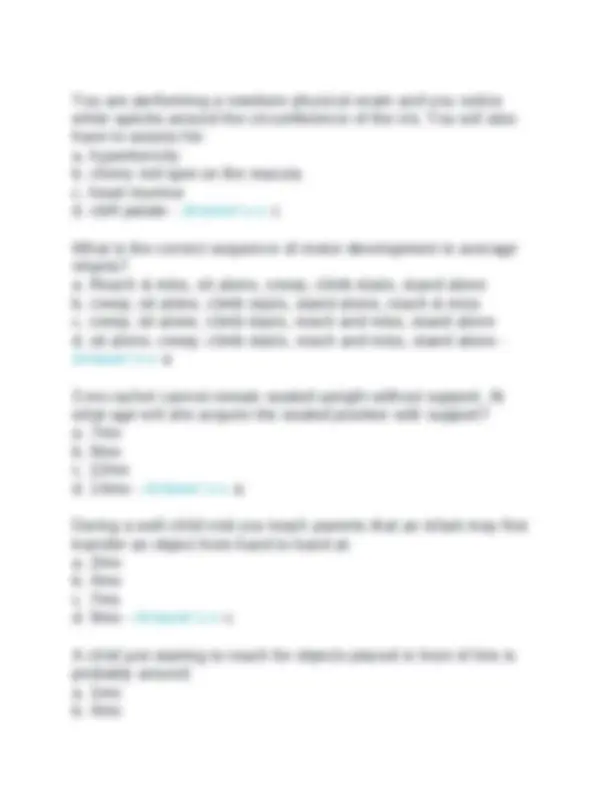
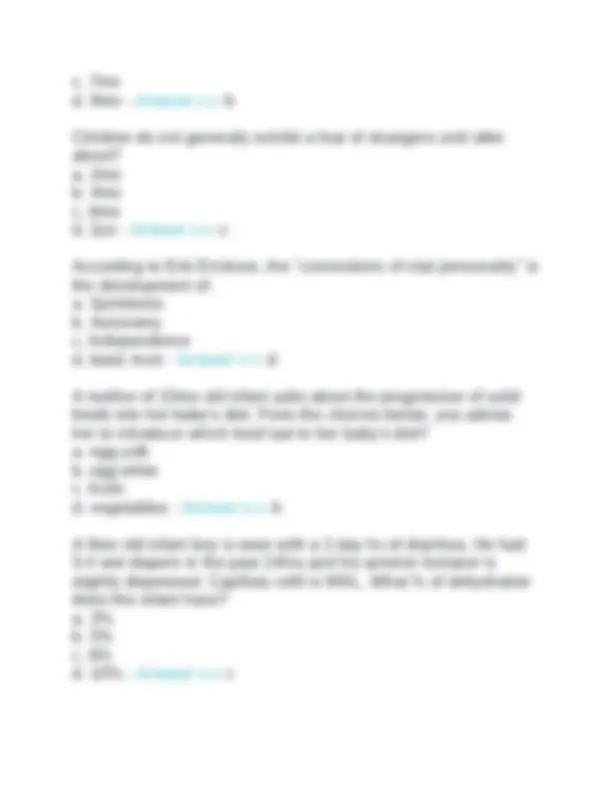
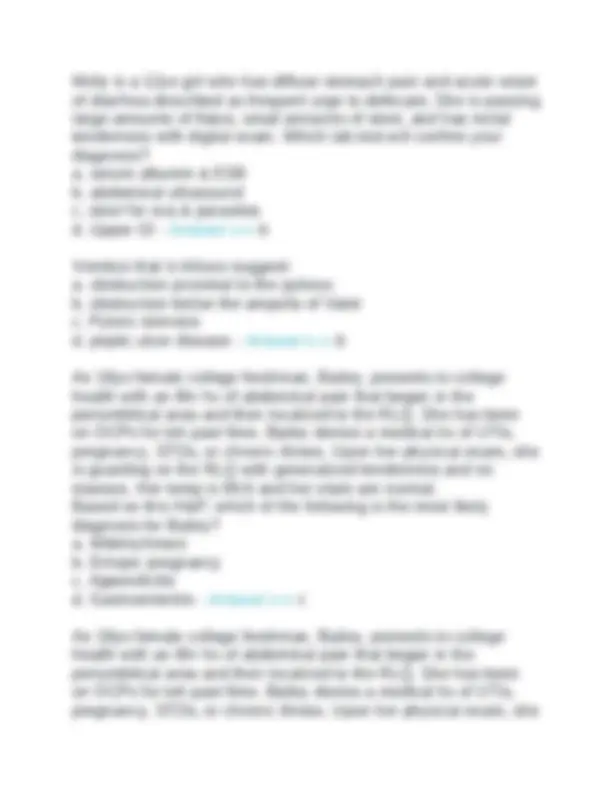
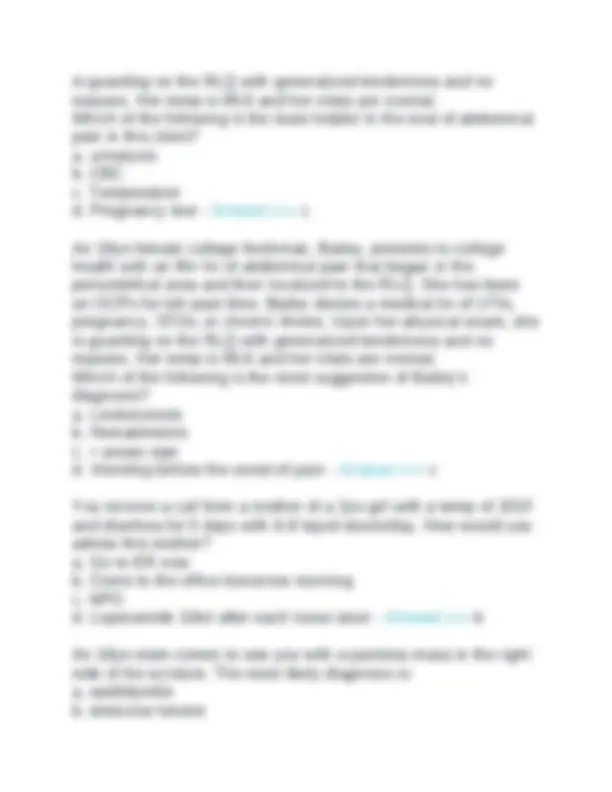
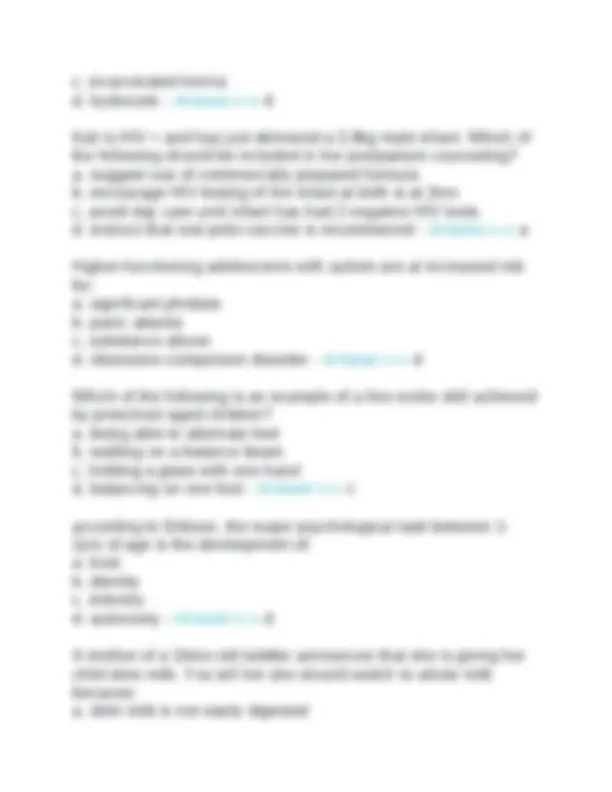
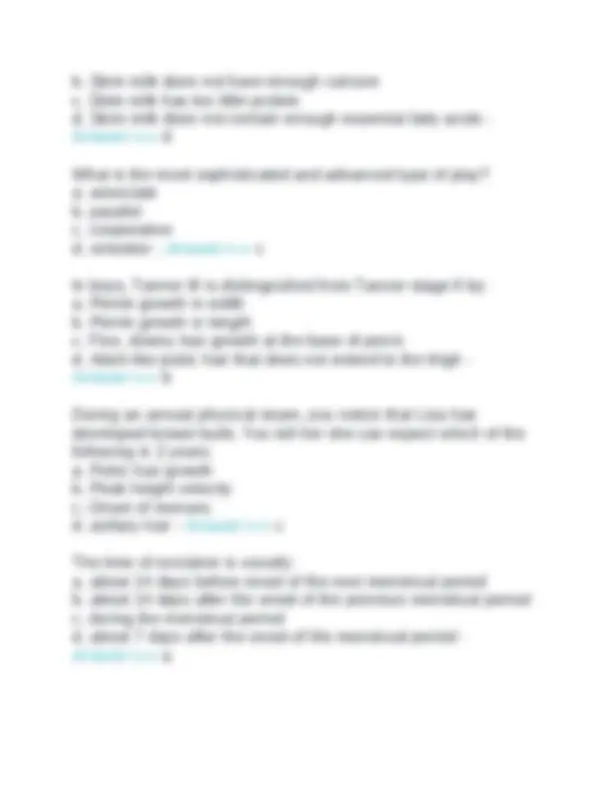
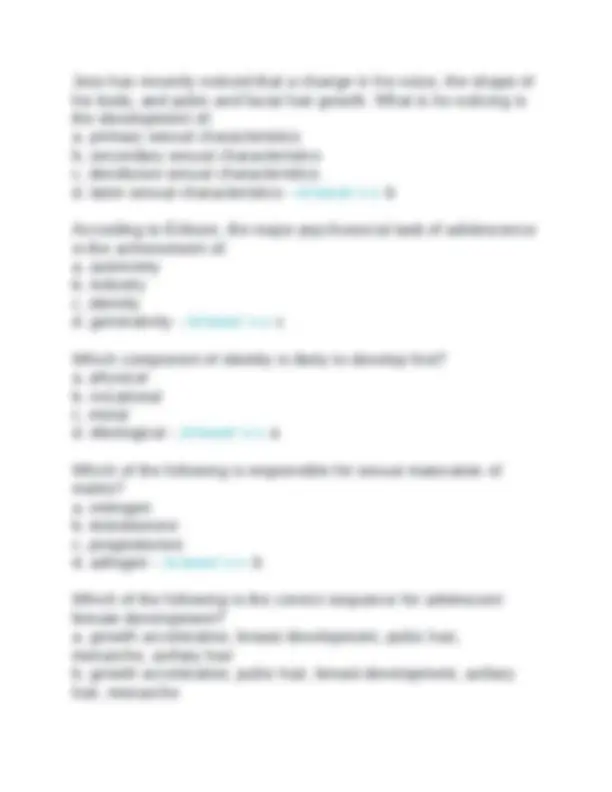
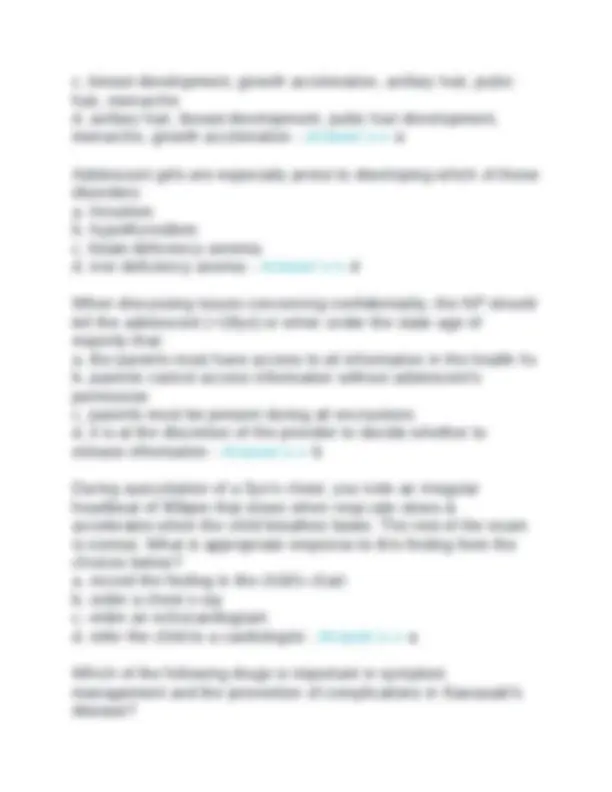
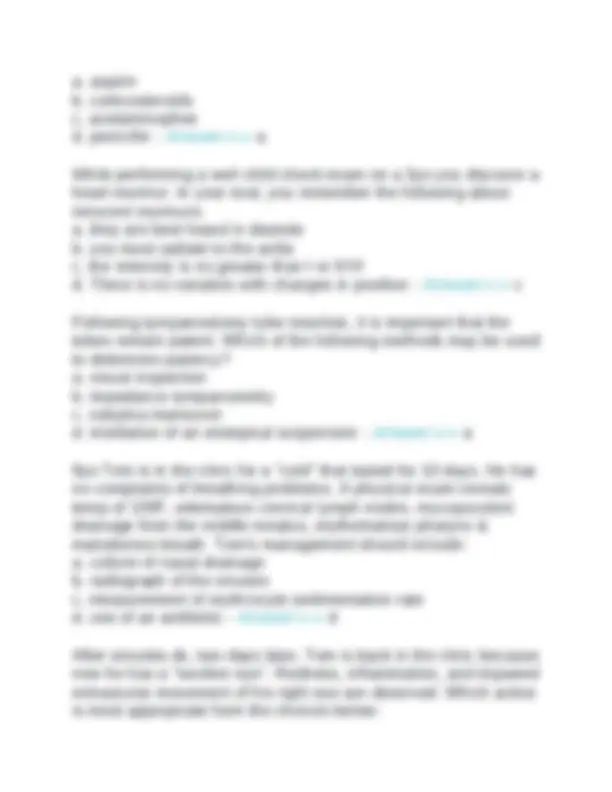
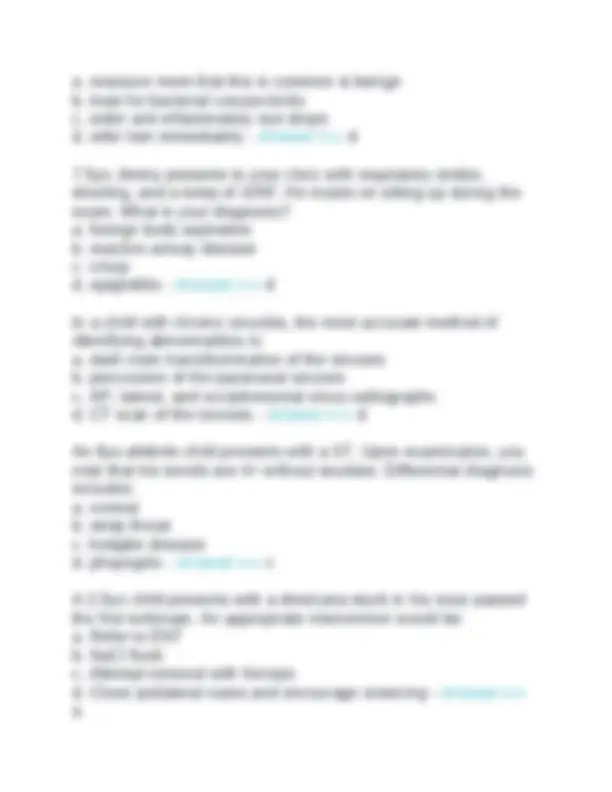
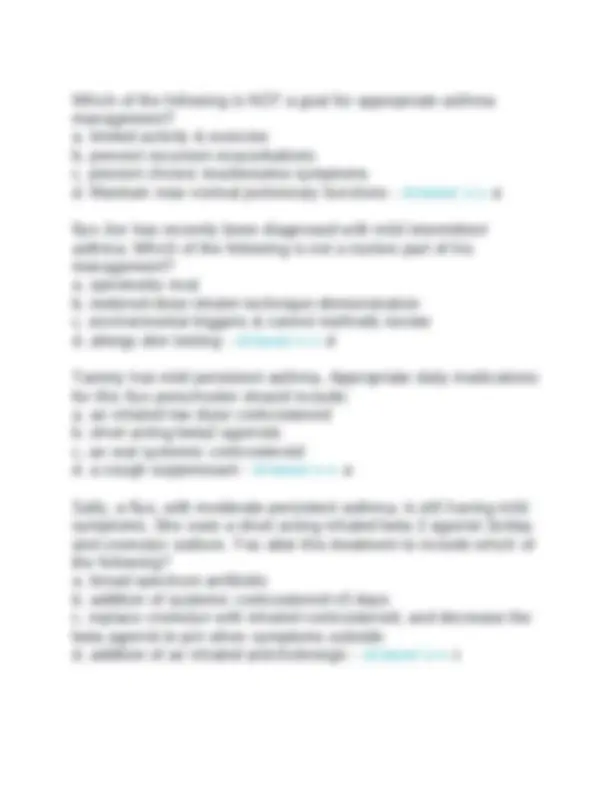
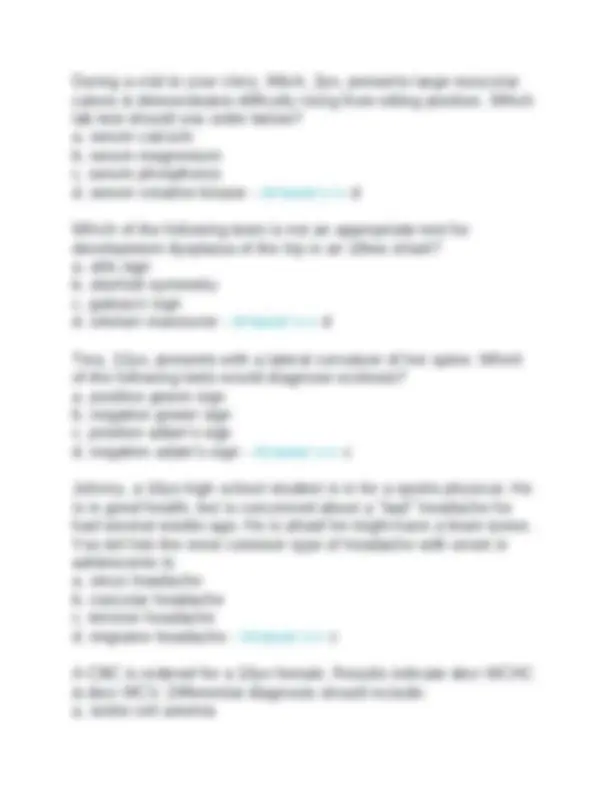
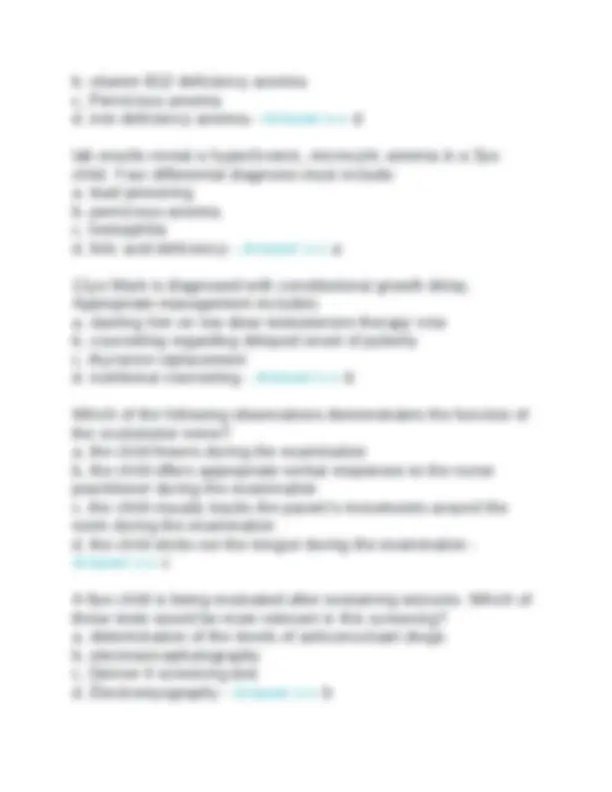
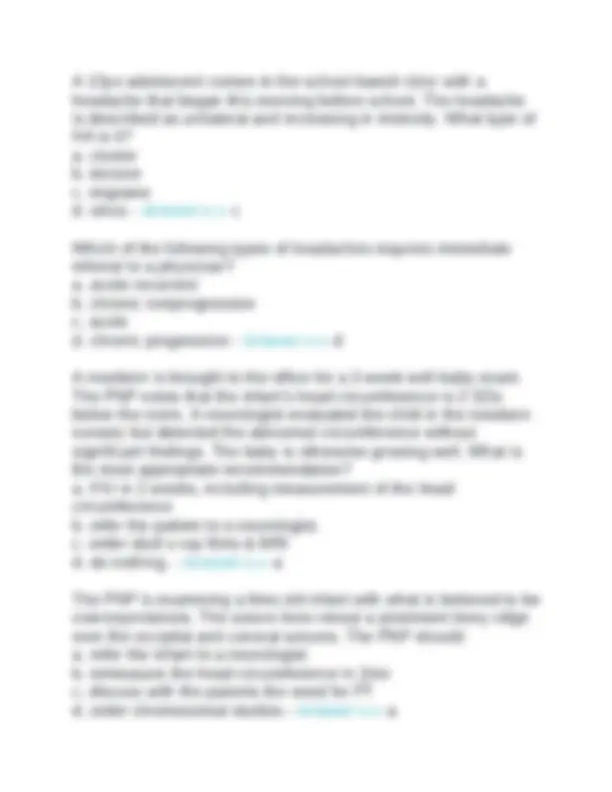
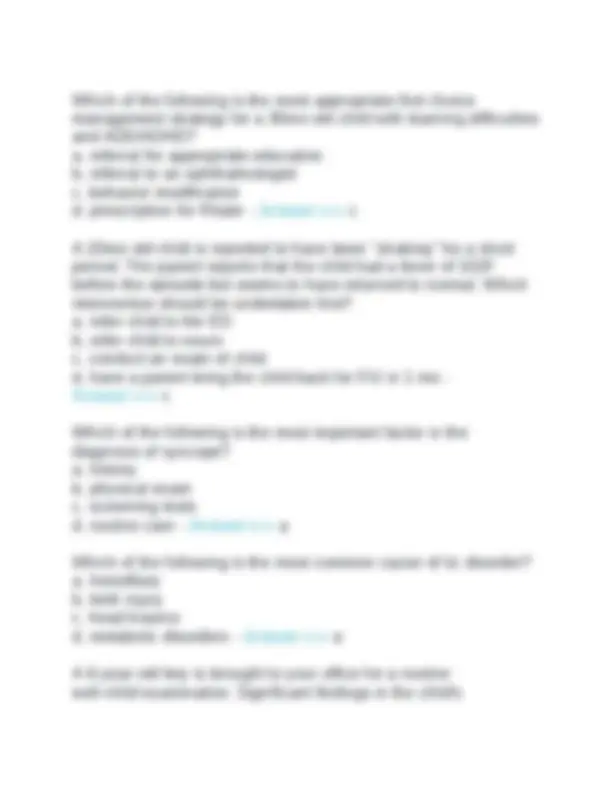
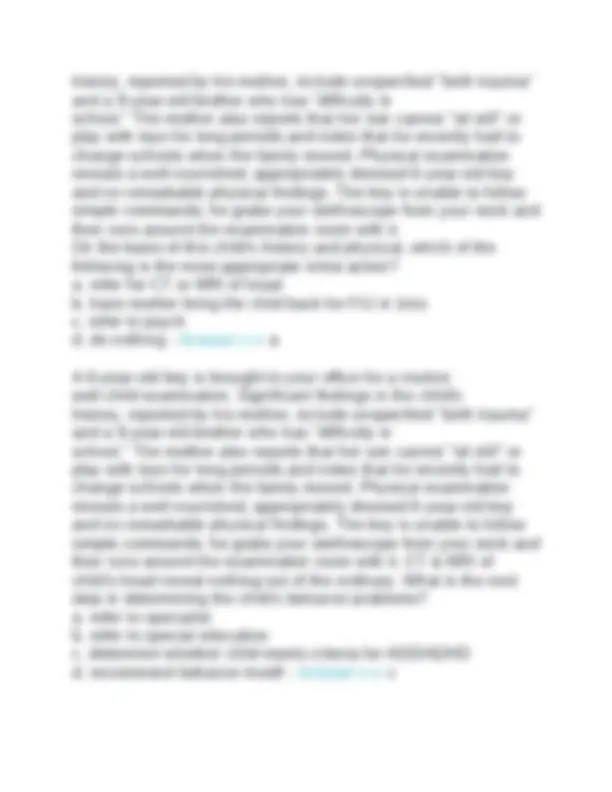
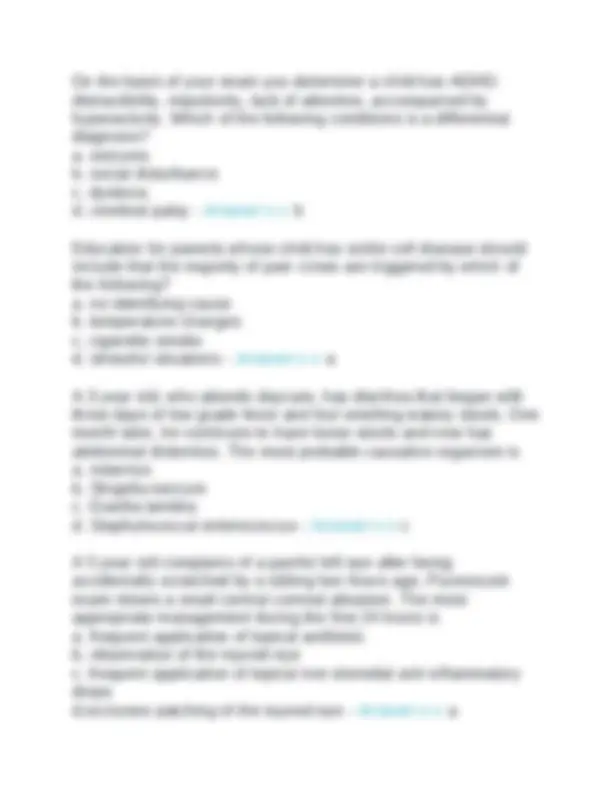
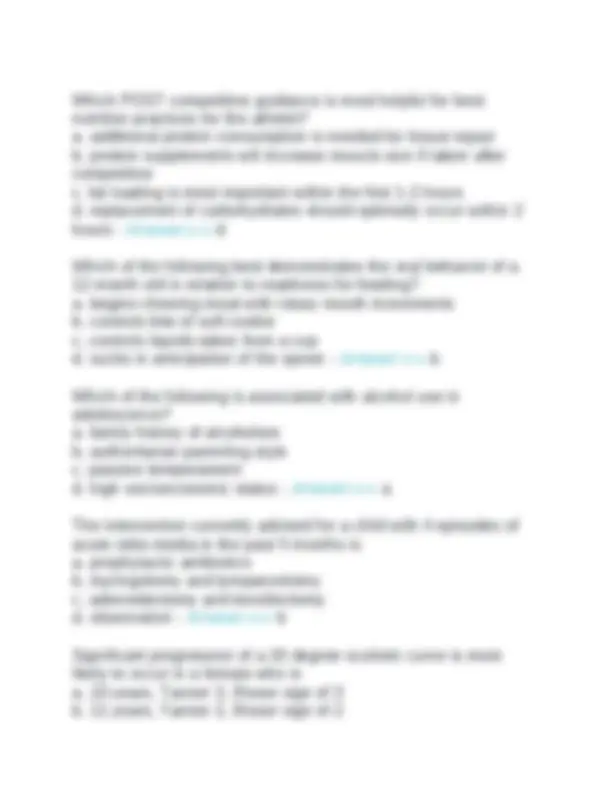
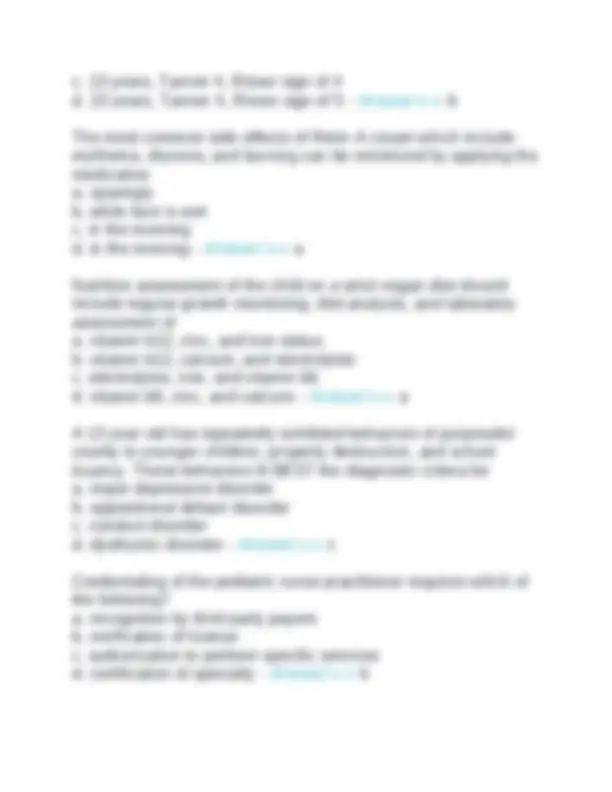
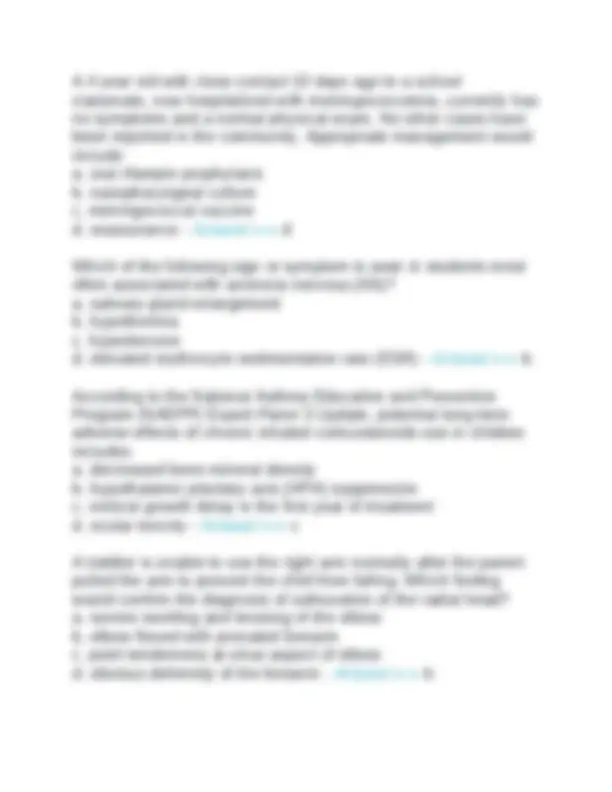
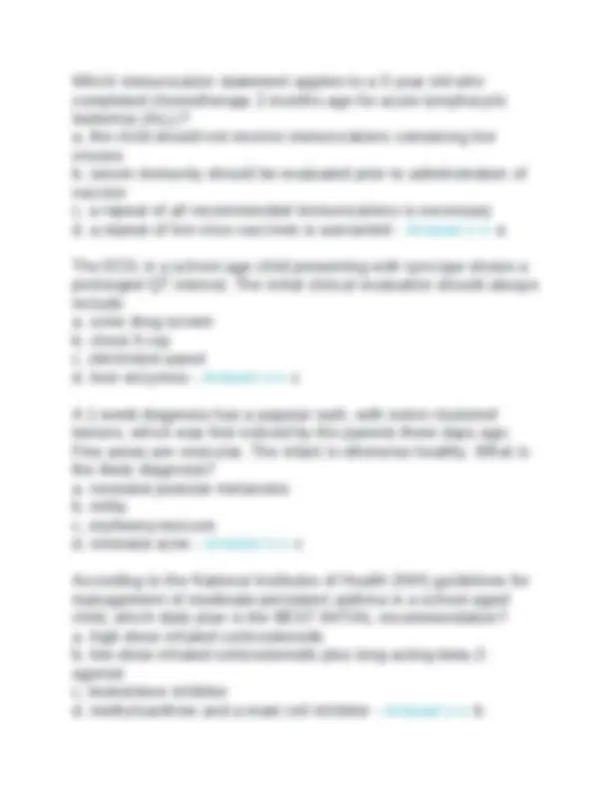
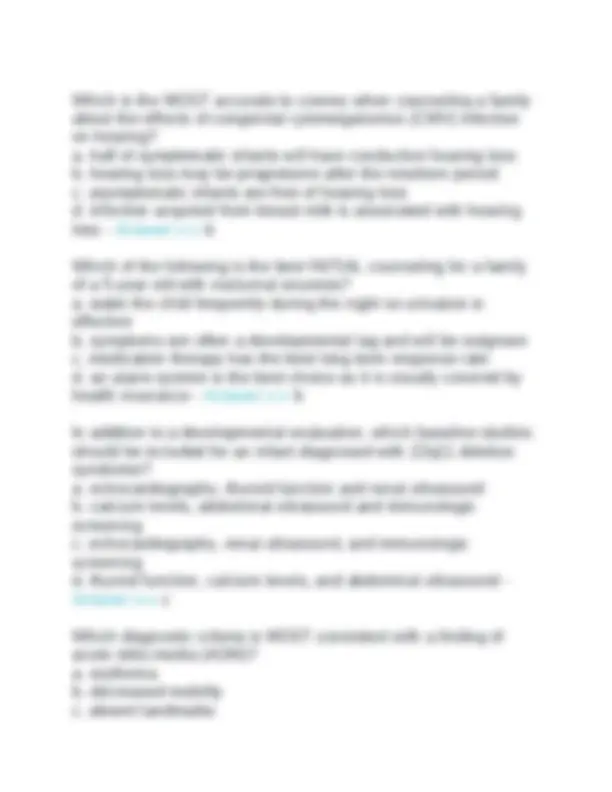
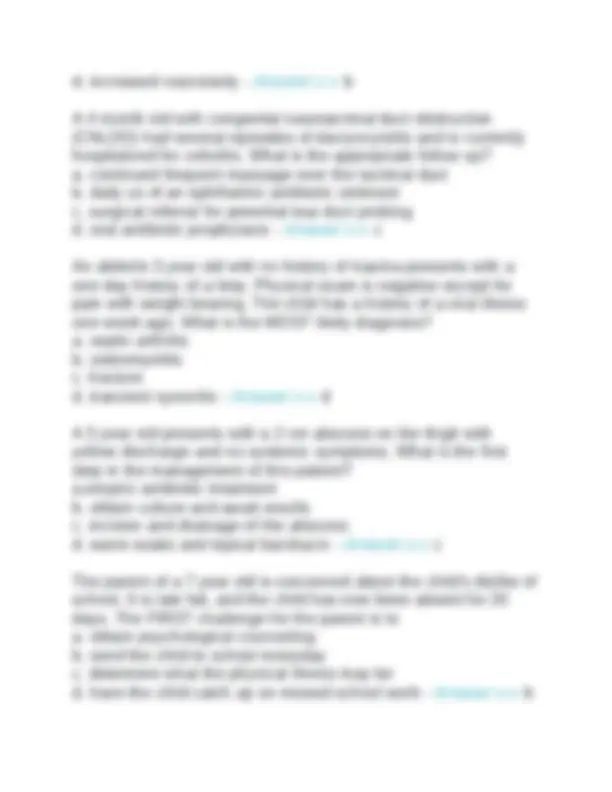
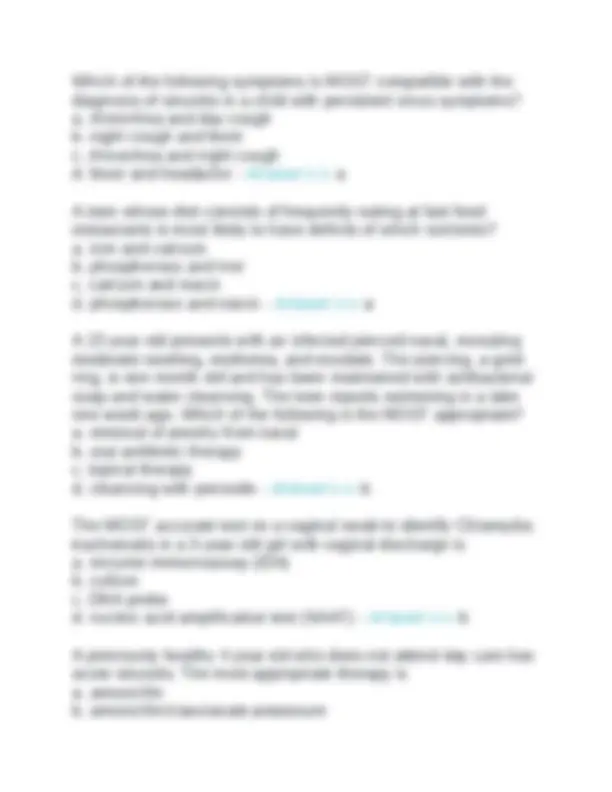
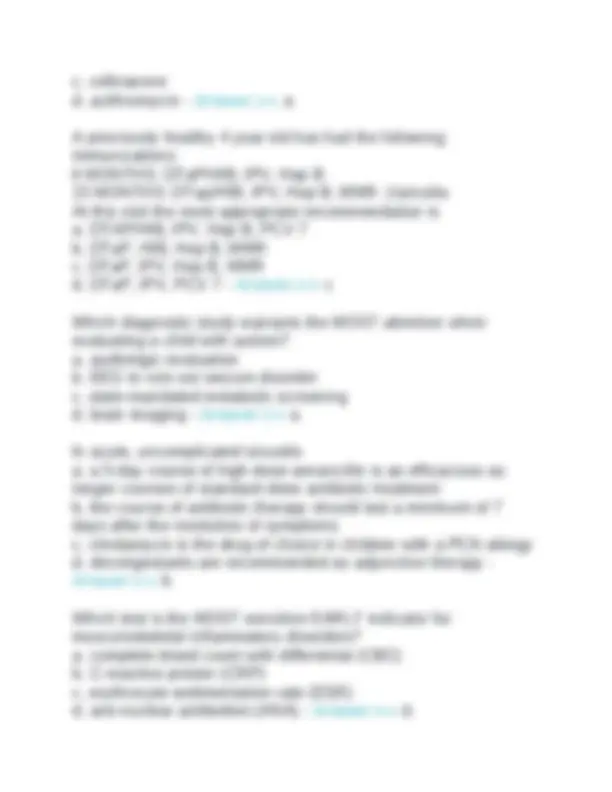
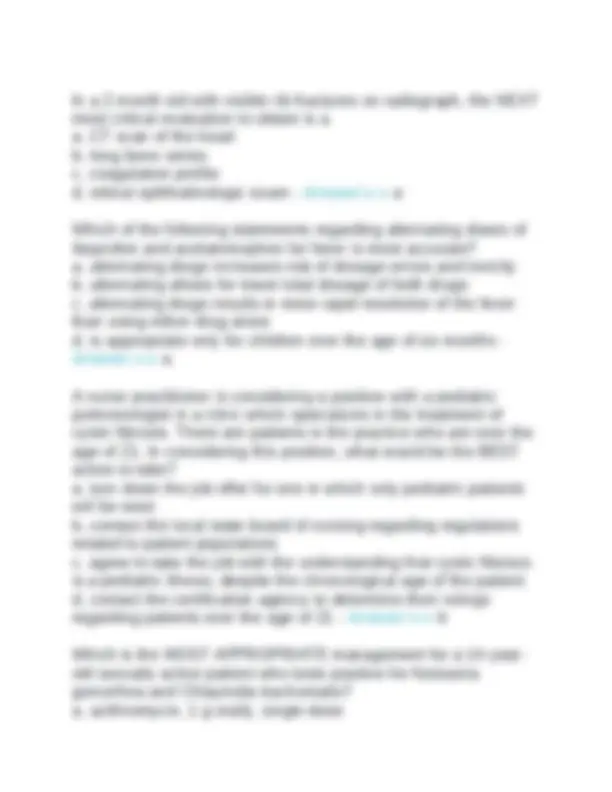
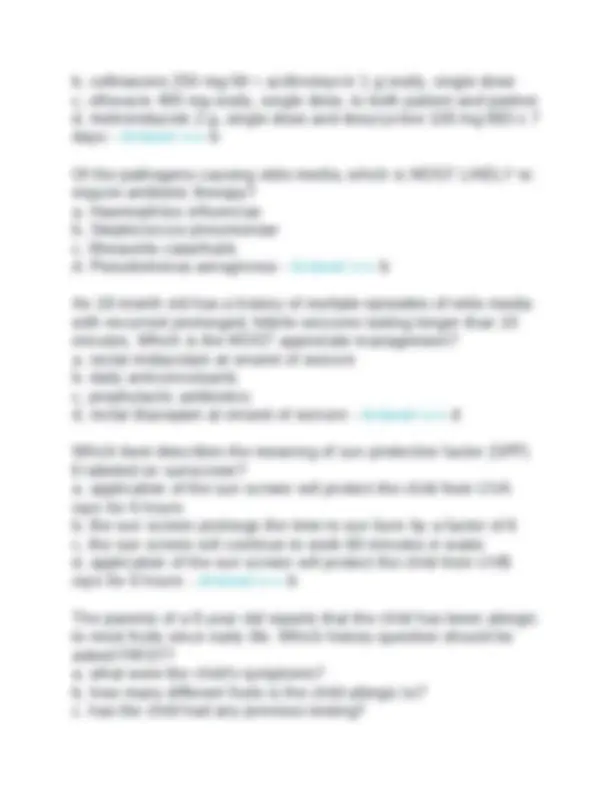
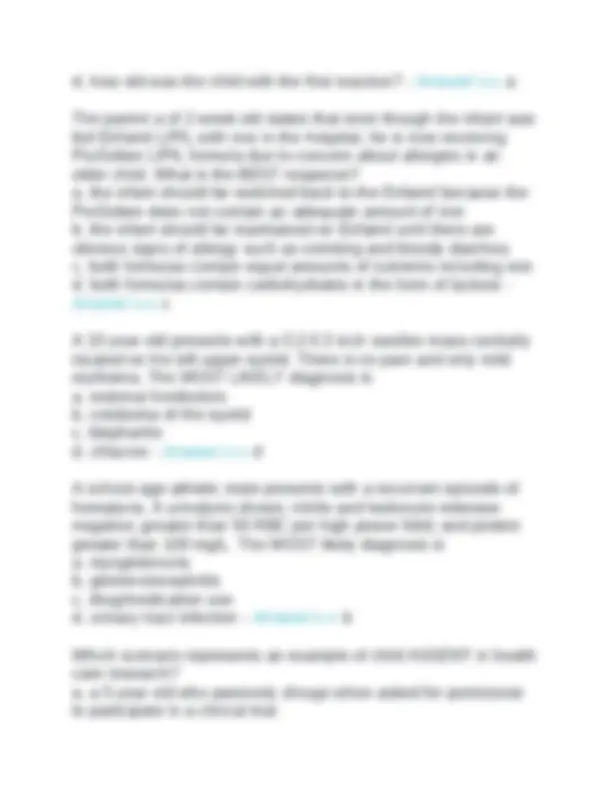
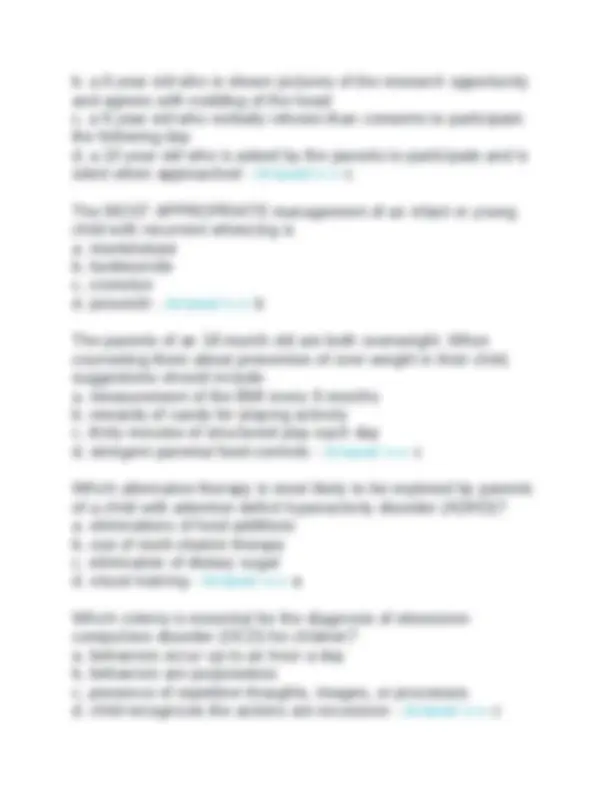
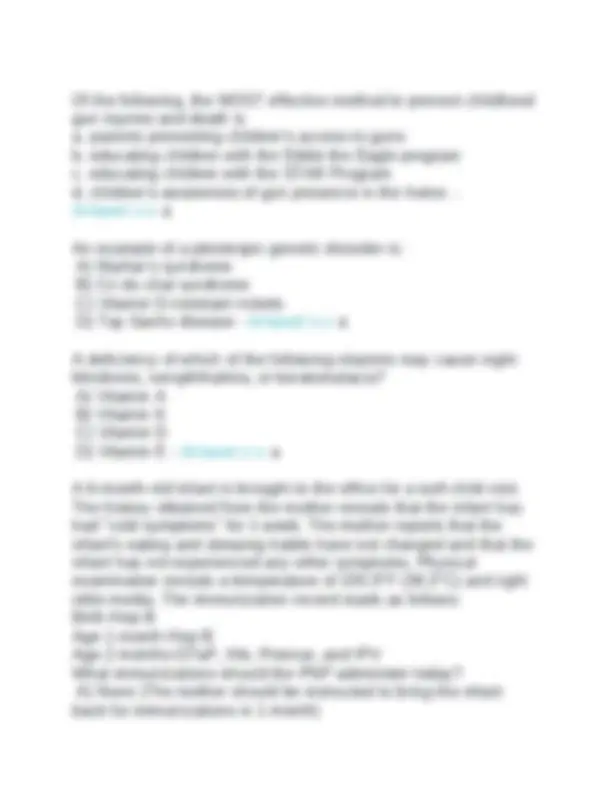
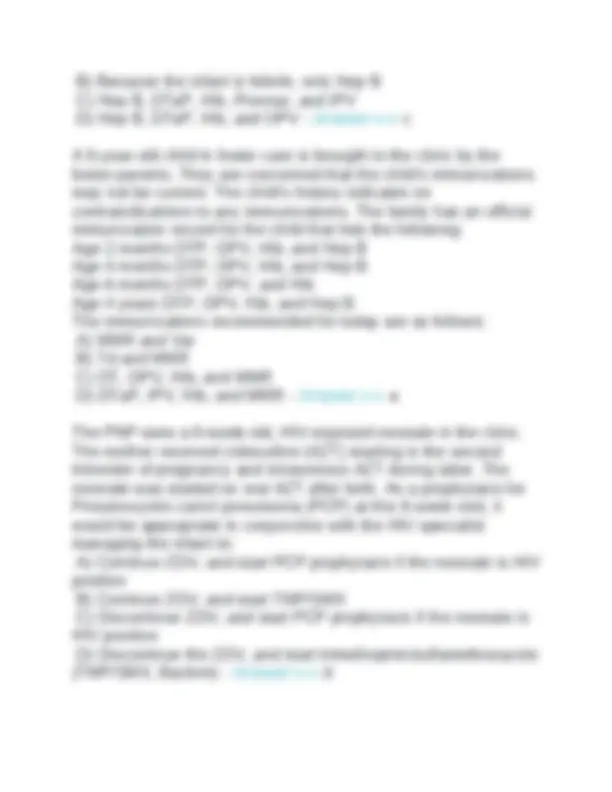
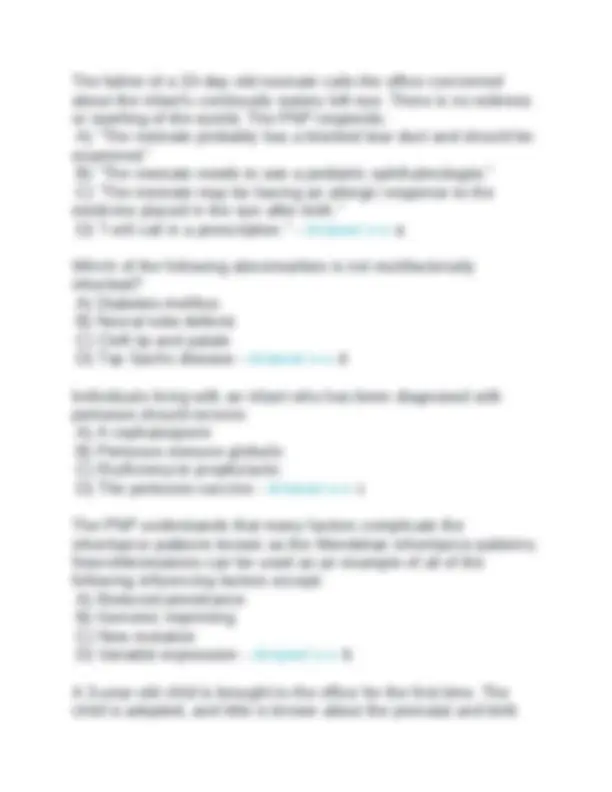
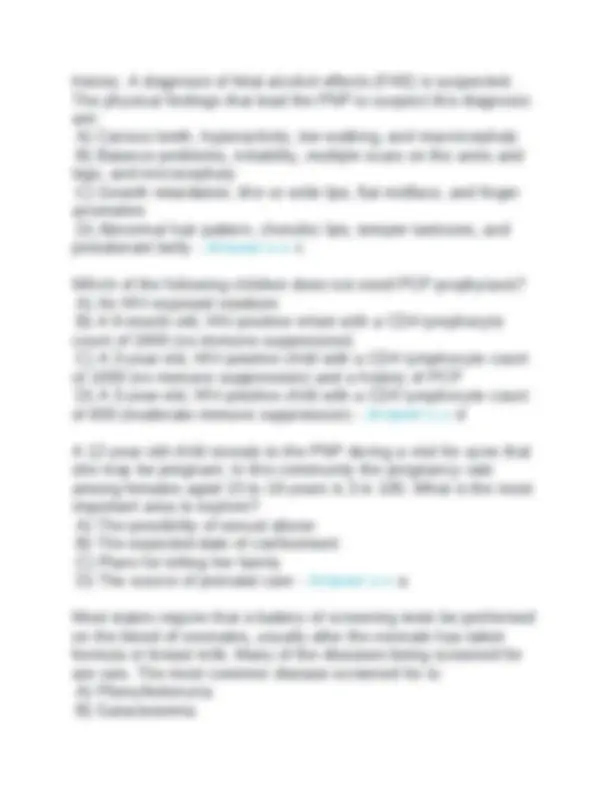
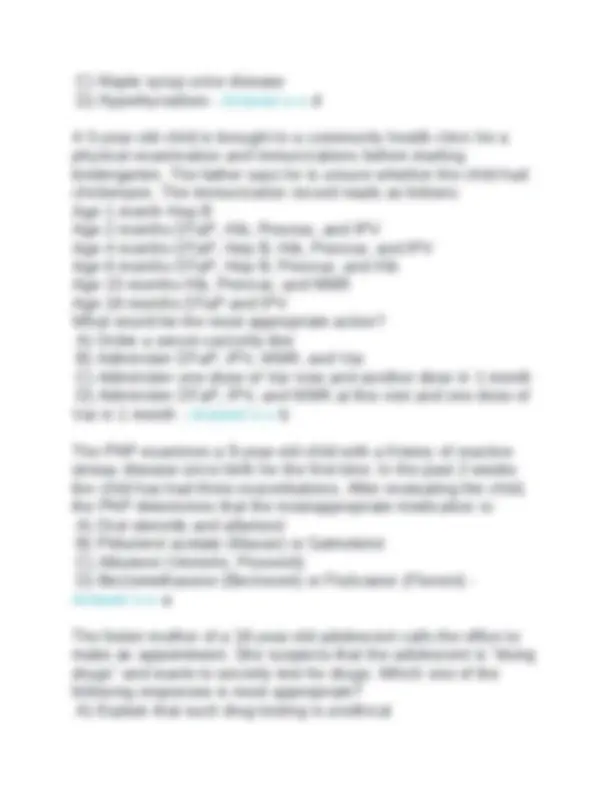
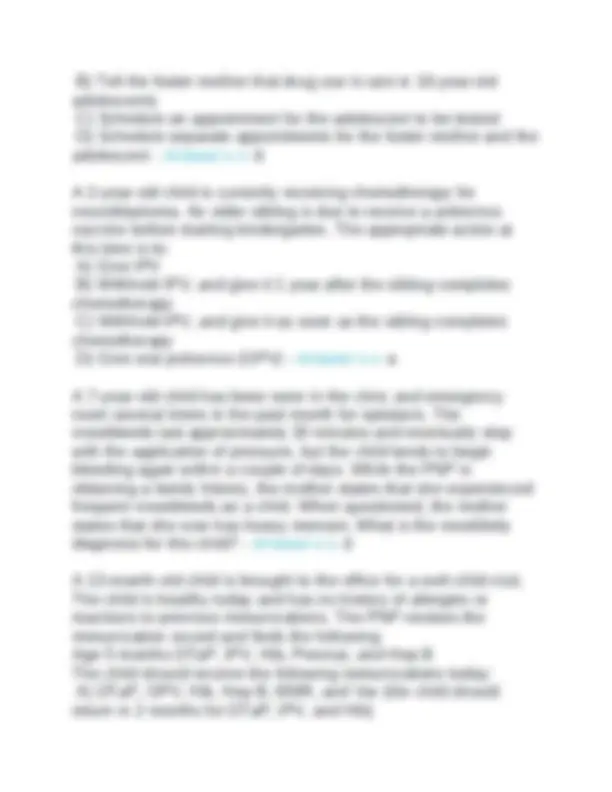
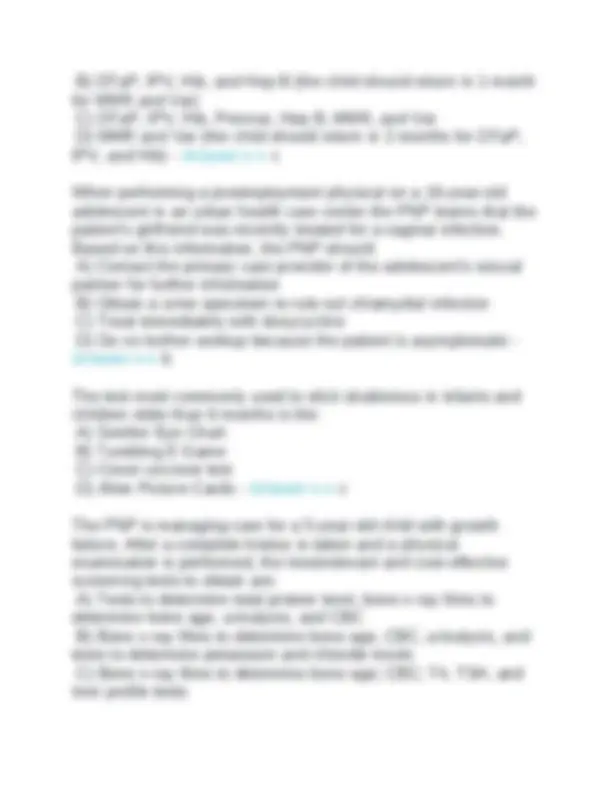
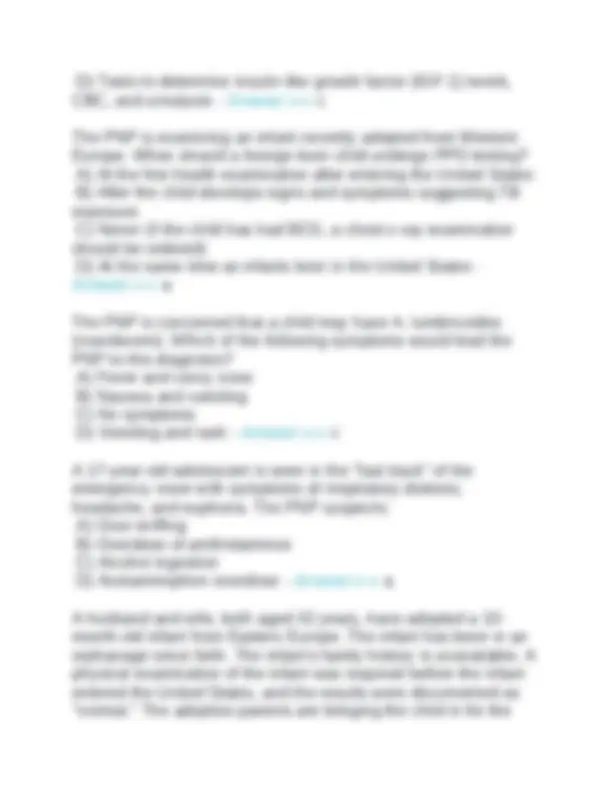
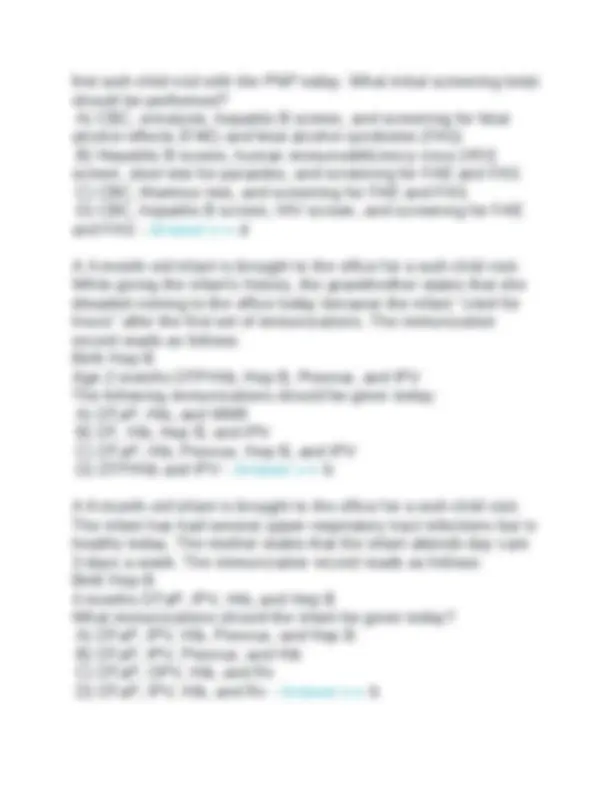
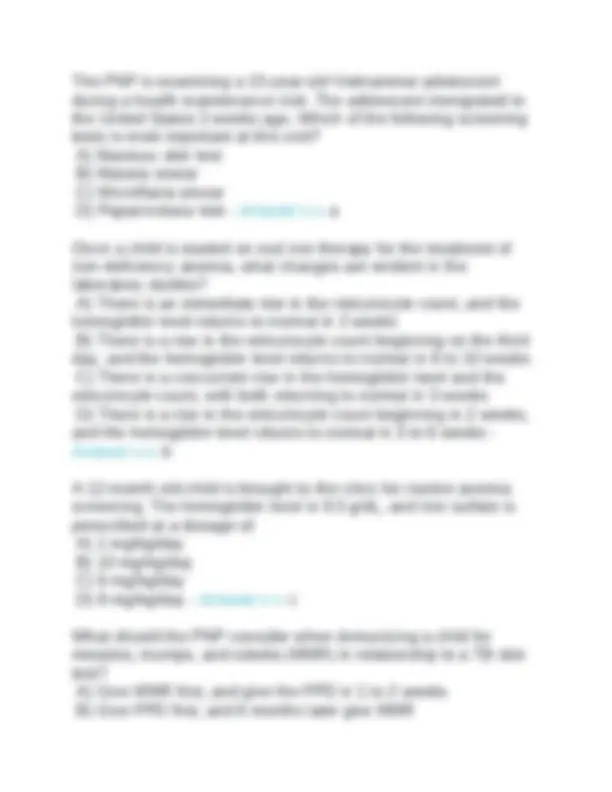
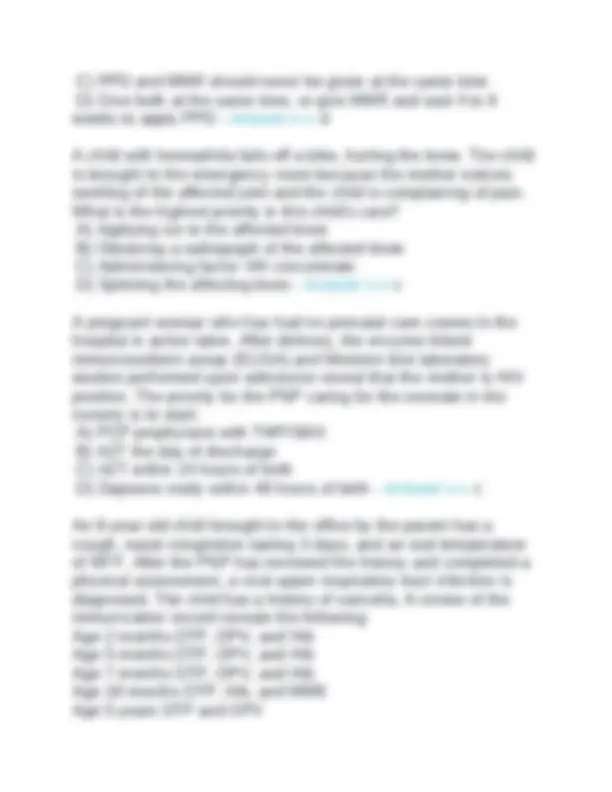
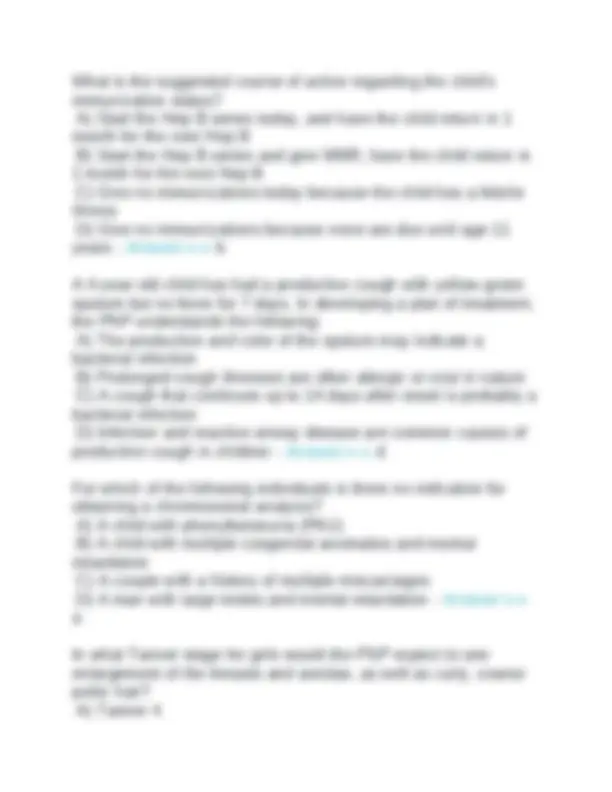
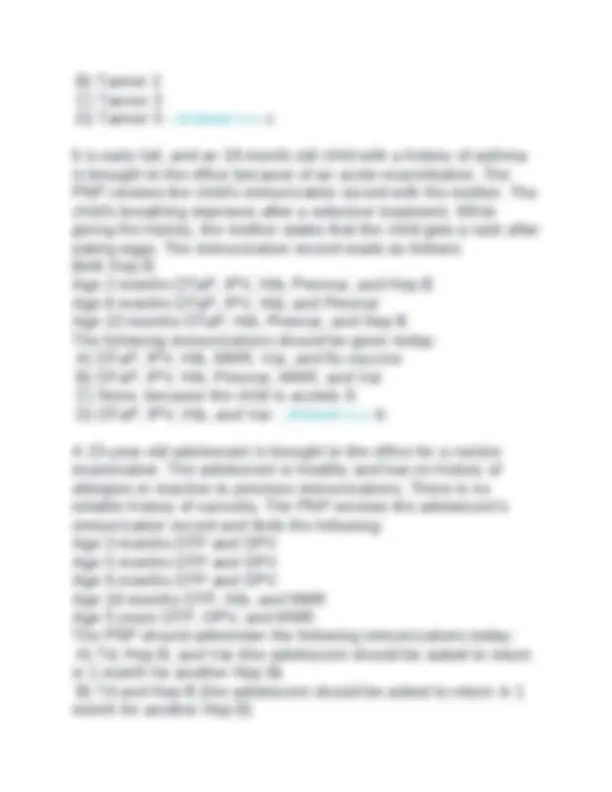
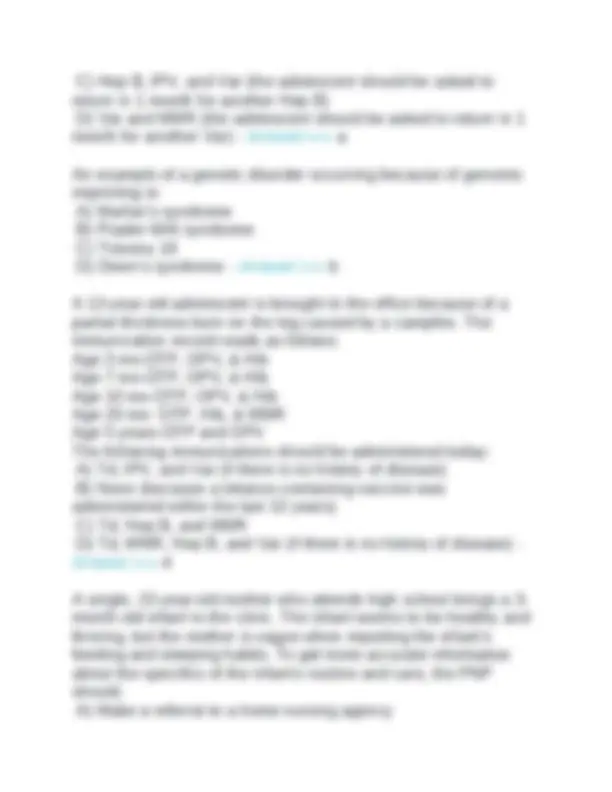
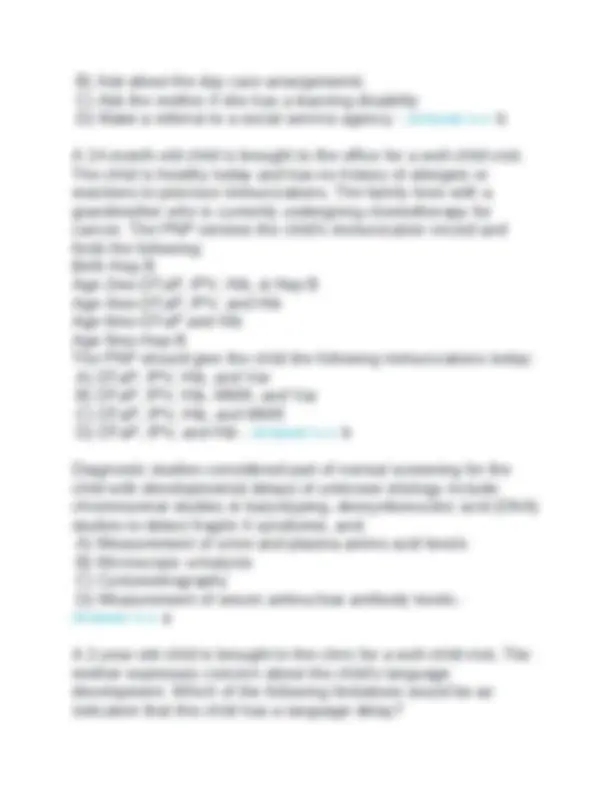


Study with the several resources on Docsity

Earn points by helping other students or get them with a premium plan


Prepare for your exams
Study with the several resources on Docsity

Earn points to download
Earn points by helping other students or get them with a premium plan
Community
Ask the community for help and clear up your study doubts
Discover the best universities in your country according to Docsity users
Free resources
Download our free guides on studying techniques, anxiety management strategies, and thesis advice from Docsity tutors
A variety of pediatric health topics, including skin conditions, respiratory issues, growth and development, infectious diseases, and more. It provides information on the characteristics, causes, and appropriate management of conditions like atopic dermatitis, asthma, microcephaly, conjunctivitis, streptococcal pharyngitis, and urinary tract infections in children. The document aims to equip healthcare professionals with the knowledge to effectively assess, diagnose, and treat common pediatric health concerns, ensuring optimal care and outcomes for young patients.
Typology: Exams
1 / 334

This page cannot be seen from the preview
Don't miss anything!





























































































The concept of health promotion consists of efforts to prevent rather than to cure disease or disability. This description best describes: a. tertiary prevention b. secondary prevention c. primary prevention d. morbidity prevention - Answer>> c Standards for well child care and health promotion are set forth by the: a. Task Force on Preventative Services, US Department of Health and Human services b. American Academy of Family Physicians c. American Academy of pediatrics d. Healthy People 2010 and 2020 - Answer>> c A 15 yo female comes to the clinic for a health maintenance visit. The patient reports no complaints. She does well in school, has many friends, and gets along well with her parents and two siblings. She has recently become sexually active with her boyfriend of 6mo. The physical exam is normal for her age. What screening, lab tests, and/or immunizations should the PNP order? a. Vision, hearing, urinalysis, STD screen, pelvic exam, and immunizations as needed b. STD screen, pneumococcal vaccine, pelvic exam, and cholesterol screening as indicated c. vision, hearing, STD screen, pelvic exam, and hemoglobin if indicated. d. Measles vaccine, vision, hearing, STD screen, pelvic exam exam, and cholesterol screen if indicated. - Answer>> a
Which of the following is the best written chief complaint? a. 5yo asian female with itchy red rash b. 1 mo with difficulty feeding c. 15yo african american female complaining of lower abdominal pain for 3 days d. 12yo caucasian with itchy eye for 1 week - Answer>> c The past history should include a. family history b. social hx c. symptom analysis d. hospitalization - Answer>> d The family history should include: a. the health status of the paternal grandparents b. the living conditions of the family c. the work status of the parents d. school information - Answer>> a Which of the following statements would be considered subjective data obtained from the client during the review of systems for the skin? a. the skin appears dry & excoriated b. a lesion is noted on the lateral aspect of the right leg c. there is moderate acne on the forehead and back d. the patient denies changes in skin texture - Answer>> d The PNP is completing the ROS on a 4mo. What response from the mother might indicate a cardiac problem in the infant & require a more thorough history? a. the baby gets the hiccups often. b. it takes the baby over 30min to complete a bottle c. the baby's heart seems to beat rapidly sometimes d. sometimes the baby sounds congested - Answer>> b
A healthy 12yo female is at the clinic for a well checkup. On physical examination, a marked elevation of the right scapula and right thoracic hump and spinal curve abnormally are noted. Spinal films indicate 20 degree curve. The PNP should: a. refer the patient to an orthopedist b. monitor the patient every 3 mo until menarche c. refer the patient for physical therapy d. recommend bedrest and back brace - Answer>> a What is the % of risk an autosomal dominant gene is being passed on to each offspring? a. 25 b. 50 c. 100 d. none - Answer>> b A 13yo female is at the clinic for a routine check up. What presenting symptoms might alert the PNP to the presence of a possible genetic disorder? a. <10% on growth chart, Tanner I, and learning difficulties b. Precocious puberty, developmental delays, gifted piano player c. Lactose intolerance, frequent ear infections, speech delays d. Peanut allergy, right-sided weakness, and exhibits bullying behavior - Answer>> a The parents of a child with cystic fibrosis are considering another pregnancy. They want to know what their chances are of having another child with cystic fibrosis. The PNP explains that cystic fibrosis is an autosomal recessive disorder and that each conception of carrier parents has a: a. 25% chance of being affected b. 50% chance of being affected c. 75% chance of being affected d. 100% chance of being affected - Answer>> a
The parents of a son with hemophilia are considering another pregnancy. The mother has been identified as a carrier of the hemophilia gene. What chance does each female offspring have of having hemophilia. a. 100% b. 50% c. 25% d. none - Answer>> d A male with Vitamin D-resistant rickets asks what his chances are of passing his disease to his parents. The PNP answers: a. all sons will be affected by only 25% daughters b. all daughters are affected by only 25% sons c. 50% of all offspring will have the disease d. all daughters will be affected but no sons. - Answer>> d The PNP is following a 15-year-old male adolescent with consistent blood pressure readings of 132 to 138/84 to 86 mm Hg, which is classified as significant hypertension. After performing a workup, the PNP determines that the adolescent has primary hypertension. The most judicious recommendation for therapy is: A) Diet and exercise counseling and referral to a specialist B) A diuretic, low-salt diet, exercise, and counseling by a dietician C) Perform an extensive family history to determine other risk factors D) A vasodilator, restricted activity, and a low-fat diet - Answer>> a The PNP is examining a neonate with a heart murmur. The S sound is loudest at the apex. The respiratory rate is 65 breaths per minute, and the heart rate is 180 beats per minute. Which of the following would be an appropriate action by the PNP? A) Reevaluate the neonate in 24 hours
D) Immediately referring the child to an ophthalmologist - Answer>> d An adolescent is being seen at a community health center because of recurrent respiratory tract infections. The complete blood cell count (CBC) with differential shows a white blood cell count of 20,500 with 35% blast cells. The next step in managing the adolescent's care is to: A) Repeat the CBC with differential in 1 week B) Refer to a specialist in pediatric hematology C) Perform bone marrow aspiration D) Hospitalize the adolescent immediately - Answer>> b A 9-month-old infant was diagnosed with sickle cell disease shortly after birth. The mother telephones the PNP to report that the infant has a fever of 103.2°F. The best response to the mother is: A) "Take the infant to the emergency room immediately." B) "Administer a dose of ibuprofen, and call back in 6 hours if the fever continues." C) "Give extra fluids and acetaminophen, and call back tomorrow if the fever continues." D) "Give extra fluids and acetaminophen, and bring the infant to the clinic tomorrow morning." - Answer>> a A 5-year-old child has sudden onset of nonblanching purpuric lesions scattered over the body and petechiae scattered over the neck and shoulders. The mother reports that the child has been healthy, except for a cold a few weeks ago. The child is not taking any medications. Physical examination reveals a healthy, afebrile child with no other significant findings. The laboratory data show a hemoglobin level of 12.5 g/dL, white blood cell count of 6500/mm3, and platelet count of 20,000/mm3. Based on this information, what should the PNP do next?
A) Reassure the parents that these findings are consistent with acute idiopathic thrombocytopenia purpura (ITP), and advise a hematology consultation for confirmation B) Refer the child immediately to the pediatric hematology/oncology department of the nearest tertiary care center C) Report the family to the local protective services department as soon as possible because of the - Answer>> a A 4-year-old child is scheduled for a tonsillectomy and adenoidectomy. The preoperative laboratory tests indicate a prolonged active partial thromboplastin time (aPTT). The PNP should suggest that they: A) Continue with the surgery, and monitor the child closely for bleeding complications B) Cancel the surgery, and recheck the aPTT in 1 week C) Cancel the surgery, and refer the child to a hematologist D) Obtain a family history, and determine whether there are other relatives with a bleeding disorder - Answer>> c A 14-year-old adolescent, who appears to be in acute distress and is anxious, is brought to the clinic with symptoms of high fever, chills, malaise, pharyngitis, vomiting, peripheral cyanosis, tachypnea, tachycardia, low blood pressure, and erythroderma. The PNP recognizes this as toxic shock syndrome and: A) Orders a CBC and blood culture immediately B) Orders a CBC and blood culture, and sends the adolescent to an emergency room for a lumbar puncture C) Sends the adolescent to the emergency room by ambulance immediately without providing any treatment in the clinic D) Collaborates with the clinic physician to determine appropriate antibiotic use in this patient - Answer>> c
suggest left pyelonephritis. Based on the data, the most appropriate action for the PNP is to: A) Refer the child to a urologist for diagnosis and treatment B) Consult with a physician C) Provide symptomatic treatment for 24 hours, and repeat the urine dipstick test D) Send urine for culture and sensitivity testing - Answer>> b A neonate is diagnosed with trisomy 21 based on karyotyping. What type of follow-up will the infant need? A) Echocardiography; thyroid function tests at birth, 3 months, and yearly thereafter; a CBC; and an audiology consult B) An ophthalmologic evaluation, neck x-ray films by age 3 years, and referral to early intervention and parent education C) Karyotyping, echocardiography, audiologic and ophthalmologic evaluation, and referral to early intervention and parent education D) Karyotyping; echocardiography; renal ultrasonography; thyroid function tests at birth, age 3 months, and yearly thereafter; and referral to early intervention and parent education - Answer>> a The parents of a 9-year-old with primary enuresis request information regarding treatment options. When discussing alternative treatments for enuresis, the PNP offers pertinent information to help the child and parents make an appropriate decision about which treatment would be best. The family should be told: A) The alarm is the safest therapy, but the relapse rate is about 10% B) Pharmacologic therapy has the lowest relapse rate C) Motivational therapy should be used after pharmacologic treatment D) Treatment should begin with bladder awareness training - Answer>> d
A parent asks for suggestions in helping a 6-year-old child who wets the bed. What intervention would the PNP recommend for this child diagnosed with primary nocturnal enuresis? A) Use a "wet night" calendar to mark the dates of wetting accidents B) Allow the child to take care of changing wet clothes and linens C) Criticize the child when a wetting accident has occurred D) Praise any progress made by the child - Answer>> d A 10-year-old child is examined because of recurrent UTIs. A urologic workup is performed. No abnormalities are found. To help prevent future UTIs, the PNP should suggest which of the following interventions? A) Taking a 30-minute bath daily B) Avoiding showering C) Using a voiding schedule to expand the bladder D) Practicing good perineal hygiene - Answer>> d A PNP responsible for neonatal discharge rounds at the hospital examines a male infant and notes that the urethral opening appears displaced ventrally along the glans. A closer assessment reveals an undiagnosed mild hypospadias. What should the parents be told? A) Hypospadias occurs in approximately 1 in 500 neonates B) The infant should be evaluated for other anomalies of the upper urinary tract C) The infant should be assessed for undescended testes and inguinal hernia D) Routine circumcision should be performed by 6 weeks of age - Answer>> c A 15-year-old adolescent has pallor and fatigue. The CBC results are consistent with iron-deficiency anemia. What would be appropriate information to give this adolescent? A) Antacids increase the absorption of iron
A 17-year-old adolescent comes to the office to ask about a self- medication regimen for monthly menstrual cramps. The adolescent reports routinely taking 1200 mg of ibuprofen every 4 to 6 hours for the first 3 days of menses each month to relieve cramps. The PNP tells her: A) "The dose is okay because it is only a few days a month." B) "Discontinue the medication because it may impair renal or liver function." C) "The dose should be decreased because of the risk of gastrointestinal ulceration." D) "Aspirin is a better medication for relieving menstrual cramps."
D) "An antibiotic needs to be prescribed." - Answer>> b A mother calls the office and asks what she can do to decrease the discomfort her 9-year-old child is experiencing with an upper respiratory tract infection. The mother should be instructed to: A) Administer pseudoephedrine and normal saline nose drops B) Administer normal saline nose drops and benzonatate C) Place a cool-mist humidifier in the child's room, and administer benzonatate D) Administer dextromethorphan and normal saline nose drops - Answer>> a A grandfather tells the PNP that with winter coming he is planning to buy several bottles of cough syrup and treat his family members when they get colds and coughs. Although the PNP discourages this practice, the guidelines the PNP provides should include a warning that cough suppressants should be used only for: A) Coughs that occur in the morning B) Coughs that occur during exercise C) Harsh, "brassy" coughs D) Temporary dry coughs - Answer>> d A father asks the PNP if an opioid cough suppressant, such as promethazine hydrochloride with codeine (Phenergan with codeine), would help his school-aged child who is recovering from a cold and complaining of a "nagging cough." The PNP explains that possible problems of opioid cough suppressants include: A) Potential for abuse and diarrhea B) Respiratory depression and diarrhea C) Dependency and constipation D) Respiratory stimulation and constipation - Answer>> c
B) Prescribe an appropriate antibiotic to treat the sinus infection C) Reassure the father that the child probably has a viral infection and suggest supportive care; if symptoms don't improve in 7 days, return for evaluation D) Inform the father that no treatment is necessary but suggest she bring the child in if symptoms do not improve within 4 weeks - Answer>> c The PNP returns a phone call to the mother of a 2-week-old infant. The infant is breastfed exclusively and at the 1-week checkup weighed 4 oz more than at birth. The infant has not had a bowel movement in 4 days but has had more than eight wet diapers each day, is nursing vigorously, and has no signs or symptoms of illness. Appropriate counseling for this mother should include: A) Because there has been no bowel movement in 4 days, a glycerin suppository should be administered B) Rectal stimulation should be performed every hour until a bowel movement is produced C) No treatment is necessary; the mother should be reassured only D) The infant should be evaluated in the gastroenterology clinic - Answer>> c While examining a 3-year-old child for a well-child visit, labial adhesions are noted. The PNP discusses with the mother: A) Concern of sexual abuse B) Proper hygiene C) Causes of UTI D) Surgical treatment of the adhesions - Answer>> b A 10-month-old infant is brought to the clinic for a rash. The rash is circumscribed, dry, pruritic, slightly flaky, and located on the cheeks and flexor surface of the arms. What treatment should the PNP prescribe?
A) Bathe the infant frequently, and apply Vaseline to the rash B) Bathe the infant once a week with Dial soap and apply Gold Bond cream to the lesions C) Bathe the infant daily with mild soap, such as Dove, and apply Eucerin cream daily D) Bathe the infant daily or every other day with Dove soap and apply a high potency corticosteroid cream, paying particular attention to the cheeks - Answer>> c In providing anticipatory guidance to the parents of a 5-year-old child with diabetes, the PNP should teach them to recognize the symptoms of sweating, hunger, drowsiness, and confusion. These are all symptoms of: A) Diabetic ketoacidosis B) The dawn phenomenon C) Hypoglycemia D) The Somogyi phenomenon - Answer>> c An 18-month-old child is brought to the office for irritability, nightmares, and generally being tired for the past few nights. The child has had an upper respiratory tract infection for which the grandmother has administered an over-the-counter medication for rhinorrhea. The child is afebrile and alert, with obvious clear rhinorrhea. The PNP: A) Orders sinus radiologic studies B) Prescribes amoxicillin C) Discusses side effects of decongestants and antihistamines D) Suggests that the grandmother administer acetaminophen - Answer>> c A 16-year-old presents with pallor and fatigue for the past several weeks. The complete blood count (CBC) results are consistent with iron deficiency anemia. What should the PNP tell this teen? A) Antacids increase the absorption of iron B) Dairy foods are good sources of dietary iron
D) Diarrhea - Answer>> a Which of the following findings suggests a need for further evaluation for glomerular disease? A) Blood pressure of 135/ B) +1 protein and red blood cell (RBC) casts in the urine C) Bright red urine D) A urine culture of 100,000 bacteria/mL - Answer>> b An 8-year-old child is brought to the urgent care clinic. No chart is available for the history. The child's symptoms include tea-colored urine and periorbital edema, and the blood pressure is 142/90. There is no dysuria or frequency. Poststreptococcal acute glomerulonephritis (PSAGN) is suspected. Which of the following statements is correct? A) PSAGN typically begins 28 days after a streptococcal infection B) Appropriate antibiotic treatment prevents nephritogenic group A beta-hemolytic streptococcal (GABHS) infection C) The urine test reveals no RBC casts or proteinuria D) Treatment in the acute phase may require salt restriction, diuretics, and antipyretics; the expected outcome is good - Answer>> d An 8-year-old child with spina bifida is examined in the clinic. The mother states that the child was doing well until attending a party at school today. Physical examination reveals a cooperative child with mild, clear rhinorrhea; red, watering eyes; generalized hives; edema of the face and eyes; and no acute respiratory symptoms. What would be the most appropriate question to ask when looking for the possible cause of an allergic reaction in this child? A) "What foods did you eat?" B) "Have you been exposed to anything new?" C) "Were there any balloons at the party?" D) "Did a bee or insect sting you?" - Answer>> c
A 12-year-old child is seen in the school-based clinic because of a red, swollen, tender area on the upper eyelid. The PNP prescribes: A) A topical steroid to be applied to the inflamed eyelid B) Warm compresses to be applied two to three times a day and a topical antibiotic C) A systemic antibiotic for 2 weeks D) A systemic antihistamine and a steroid cream - Answer>> b A 14-year-old adolescent has an annular rash (erythema migrans) on the legs with some clearing in the center of the lesions. The rash has appeared and disappeared over the last few weeks. The adolescent also complains of fever, myalgia, and headache. Which of the following subjective data would be most helpful in making a diagnosis for this condition? A) The rash is pruritic and feels warm B) The adolescent recently went backpacking in wooded area C) A sore throat developed 3 days ago D) The adolescent went on a hiking trip 3 days ago in Southern California - Answer>> b A 2-month-old infant has symptoms of a severe cough followed by vomiting. The infant had an upper respiratory tract infection 2 weeks before the onset of coughing. The PNP suspects pertussis and orders a chest x-ray film and culture of the nasopharynx. The PNP refers the infant for hospitalization and begins treatment with: A) Erythromycin B) Trimethoprim/sulfamethoxazole C) Corticosteroids and beta-agonist aerosol D) Amoxicillin - Answer>> a A 15-year-old adolescent is brought to the clinic with jaundice, anorexia, and nausea. The adolescent is concerned that she may